Gigaset Communications S455 UPCS Base Station User Manual S450IP KBA laender
Gigaset Communications GmbH UPCS Base Station S450IP KBA laender
Contents
- 1. User Manual
- 2. Users Manual
- 3. Test Setup Photos
Users Manual
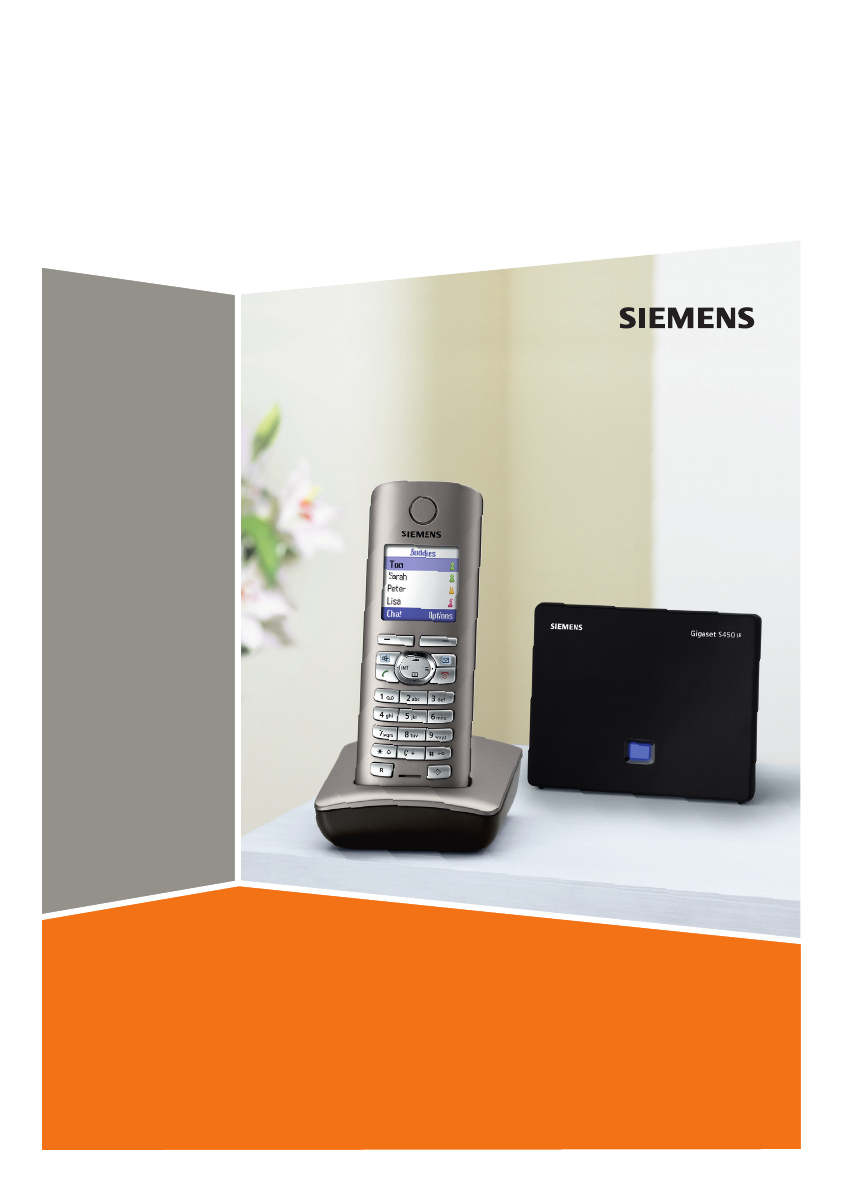
S450 IP
Gigaset
cyan magenta yellow black Liebreich Medienproduktion
Issued by
Siemens Home and Office Communication Devices GmbH & Co. KG
Schlavenhorst 66
D-46395 Bocholt
© Siemens Home and Office Communication Devices GmbH & Co. KG 2006
All rights reserved. Subject to availability.
Rights of modification reserved.
www.siemens.com/gigaset
BA Cover S450 IP.qxd 14.07.2006 17:42 Uhr Seite 1
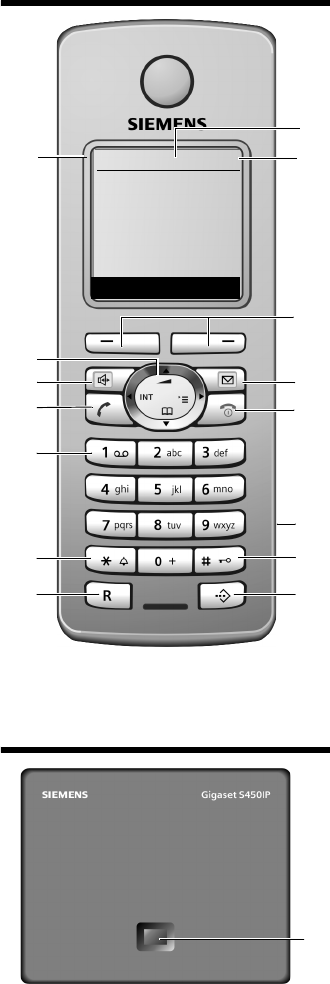
1
The handset at a glance
Gigaset S450 IP / EN-Master / A31008-M1713-B121-1-43 / overview.fm / 7.9.06
Version 4, 16.09.2005
The handset at a glance
Base station at a glance
Handset keys
1Display in idle status (example)
2Battery charge status
e V U (1/3 charged to fully charged)
= flashes: battery nearly empty
e V U flashes: battery charging
3Display keys (page 19)
4Message key
Opens calls and message lists
Flashes: new message or new call
5End call key, On/Off key
End call, cancel function, go back one menu
level (press briefly), back to idle status
(press and hold), activate/deactivate hand-
set (press and hold in idle status)
6Connection socket for headset
7Hash key
Keypad lock on/off (press and hold,
page 19)
Switch between upper/lower case letters
and digits for text entry
8Call-by-call list key (not for VoIP)
Open call-by-call list
9Recall key (not for VoIP)
Enter flash (press briefly)
Insert a pause (press and hold)
10 Star key
Ringtones on/off (press and hold in idle
status)
Open special characters table
11 Key 1 (press and hold)
Call the network mailbox
12 Talk key
Accept a call, open last number redial list
(press briefly in idle status), select connec-
tion type and start dialling (press briefly/
press and hold after entering the number,
page 17)
13 Handsfree key
Switch between earpiece/handsfree mode
Lights up: handsfree talking activated
Flashes: incoming call
14 Control key (page 19)
15 Signal strength
Ò Ñ i (low to high)
| flashes: no reception
Base station key
1Paging key
Lights up: LAN connection active (phone is
connected to router)
Flashes:
data transfer to LAN connection
Press briefly: start paging
Press and hold:
set base station to registration mode
15 2
3
5
4
7
8
14
13
11
9
10
1
12
ÐV
INT 1
10.06.06 09:45
FixedLine IP
6
1
2
Contents
Gigaset S450 IP / EN-Master / A31008-M1713-B121-1-43 / S450IP_KBA_laenderIVZ.fm / 7.9.06
Version 4, 16.09.2005
Contents
The handset at a glance . . . . . . . 1
Base station at a glance . . . . . . . . 1
Safety precautions . . . . . . . . . . . . 3
Gigaset S450 IP –
More than just a telephone . . . . . 4
VoIP – Making calls via
the Internet . . . . . . . . . . . . . . . . . . 5
First Steps . . . . . . . . . . . . . . . . . . . . 5
Pack contents . . . . . . . . . . . . . . . . . . . . 5
Setting up the handset for use . . . . . . . 6
Installing the base station . . . . . . . . . . 7
Connecting the base station . . . . . . . . 8
Making settings for VoIP telephony . . 10
Menu tree . . . . . . . . . . . . . . . . . . 13
Making calls with VoIP and the
fixed network . . . . . . . . . . . . . . . 17
Making an external call . . . . . . . . . . . 17
Ending a call . . . . . . . . . . . . . . . . . . . . 17
Accepting a call . . . . . . . . . . . . . . . . . 18
Switching between earpiece and
handsfree mode . . . . . . . . . . . . . . . . . 18
Dialling emergency numbers . . . . . . . 18
Operating the handset . . . . . . . . 19
Activating/deactivating the
handset . . . . . . . . . . . . . . . . . . . . . . . . 19
Activating/deactivating the
keypad lock . . . . . . . . . . . . . . . . . . . . . 19
Control key . . . . . . . . . . . . . . . . . . . . 19
Display keys . . . . . . . . . . . . . . . . . . . . 19
Reverting to idle status . . . . . . . . . . . . 20
Using the directory and lists . . . 21
Directory . . . . . . . . . . . . . . . . . . . . . . . 21
Last number redial list . . . . . . . . . . . . 21
Opening lists with the message key . 22
Dialling from the directory/list . . . . . . 22
SMS (text messages) . . . . . . . . . . 23
Writing/sending/saving an SMS . . . . . 23
Receiving/reading an SMS . . . . . . . . . 24
Managing SMS lists . . . . . . . . . . . . . . 24
Notification by SMS . . . . . . . . . . . . . . 24
E-mail notifications . . . . . . . . . . 25
Entering access data for the
incoming e-mail server . . . . . . . . . . . . 25
Opening the incoming message list . . 25
Messenger . . . . . . . . . . . . . . . . . 26
Establishing a connection,
going online . . . . . . . . . . . . . . . . . . . . 26
Opening the buddy list and chatting . 26
Receiving messages . . . . . . . . . . . . . . 27
Writing/sending messages . . . . . . . . . 27
Calling a buddy . . . . . . . . . . . . . . . . . . 27
Disconnecting, going offline . . . . . . . 27
Handset/base station settings . 28
Changing the handset display keys . . 28
Adjusting the loudspeaker volume . . . 28
Setting ringtones . . . . . . . . . . . . . . . . 28
Activating/deactivating advisory
tones . . . . . . . . . . . . . . . . . . . . . . . . . . 29
Setting the alarm clock . . . . . . . . . . . . 29
Changing the system PIN on
the base station . . . . . . . . . . . . . . . . . 29
Setting default connection . . . . . . . . . 29
Checking the base station
MAC address . . . . . . . . . . . . . . . . . . . . 30
Web configurator . . . . . . . . . . . . 30
Connecting the PC to the Web
configurator . . . . . . . . . . . . . . . . . . . . 30
De-registering . . . . . . . . . . . . . . . . . . . 30
Web configurator functions . . . . . . . . 30
Appendix . . . . . . . . . . . . . . . . . . 32
Care . . . . . . . . . . . . . . . . . . . . . . . . . . . 32
Contact with liquid . . . . . . . . . . . . . . . 32
Questions and answers . . . . . . . . . . . . 32
FCC / ACTA Information . . . . . . . . . . . . 32
Industry Canada Certification . . . . . . . 34
Safety precautions . . . . . . . . . . . 34
Specifications . . . . . . . . . . . . . . . . . . . 38
Gigaset S450 IP – Free software . . . . . 39
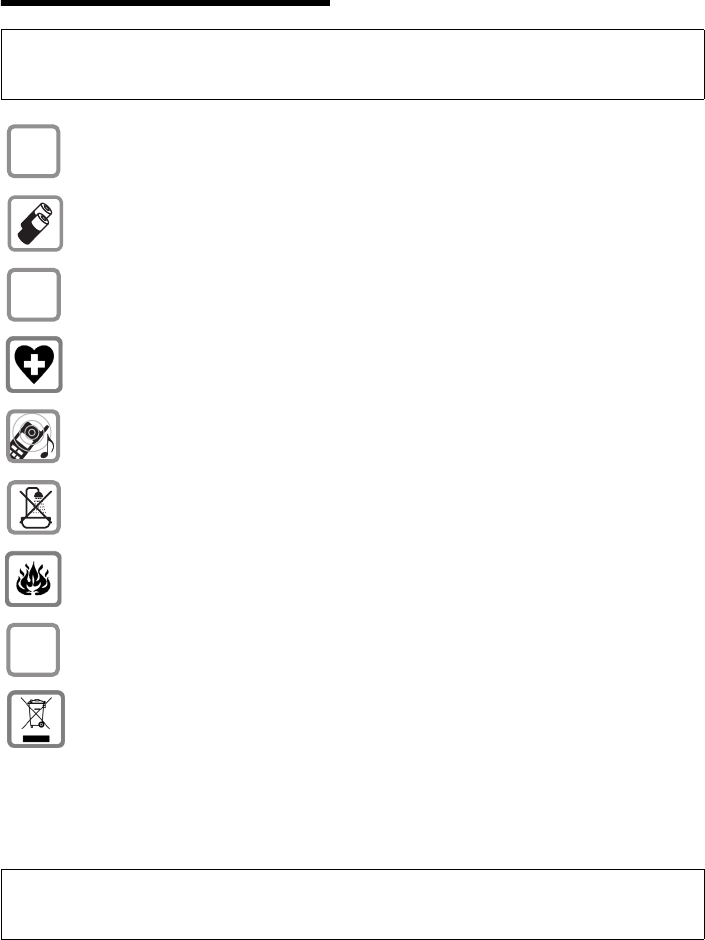
3
Safety precautions
Gigaset S450 IP / EN-Master / A31008-M1713-B121-1-43 / security.fm / 7.9.06
Version 4, 16.09.2005
Safety precautions
Warning:
Read the safety precautions and the user guide before use.
Explain their contents and the potential hazards associated with using the telephone to your children.
Only use the mains adapter supplied, as indicated on the underside of the base station.
Fit only the recommended rechargeable batteries (page 38) of the same type!
This means that you must not use any other battery type or non-rechargeable batteries as
this could result in significant health risks and personal injury.
Insert rechargeable batteries with the correct polarity, and use them according to this user
guide (symbols are attached to the inside or outside of the handset's battery compart-
ment, page 6).
The operation of medical appliances may be affected. Be aware of the technical conditions
in your particular environment, e.g. doctor's surgery.
Do not hold the rear of the handset to your ear when it is ringing or when the handsfree
function is activated. Otherwise you risk serious and permanent damage to your hearing.
The handset may cause an unpleasant humming noise in hearing aids.
Do not install the base station in bathrooms or shower rooms. The handset and base sta-
tion are not splashproof (page 32).
Do not use your phone in environments with a potential explosion hazard, e.g. paint
shops.
If you give your Gigaset to someone else, make sure you also give them the user guide.
All electrical and electronic equipment must be disposed of separately from general
household waste using the sites designated by local authorities.
If a product displays this symbol of a crossed-out rubbish bin, the product is subject to
European Directive 2002/96/EC.
The appropriate disposal and separate collection of used equipment serve to prevent
potential harm to the environment and to health. They are a precondition for the re-use
and recycling of used electrical and electronic equipment.
For further information on disposing of your used equipment, please contact your local
authority, your refuse collection service or the dealer you purchased the product from.
Note:
If the key block is switched on, even emergency numbers cannot be dialled!
Not all of the functions described in this user guide are available in all countries.
$
‹
Œ
ƒ

4
Gigaset S450 IP – More than just a telephone
Gigaset S450 IP / EN-Master / A31008-M1713-B121-1-43 / starting.fm / 7.9.06
Version 4, 16.09.2005
Gigaset S450 IP –
More than just a telephone
Your phone lets you make calls both via
the fixed network and (cost effectively) via
the Internet (VoIP) without using a PC.
And your phone can do much more
besides:
uPress a button each time you make a
call to indicate whether you want to
make a call via the fixed network or via
the Internet (page 17).
uRegister up to six handsets on your
base station. With your base station
you can make two calls simultaneously
via VoIP, or one call over the fixed net-
work and one call via VoIP.
uSet up a VoIP account with your VoIP
provider for each member of your fam-
ily with their own VoIP phone number
(up to four accounts). Together with
your fixed network number, your
phone can then be reached on up to
five different phone numbers, which
you can assign to individual handsets.
If a member of your family is called on
their number, only their handset will
ring.
uConfigure the phone connection for
VoIP without a PC. Your phone's con-
nection assistant downloads general
data about your VoIP provider from the
Internet and guides you through enter-
ing your personal data (VoIP/SIP
account). This makes it easy for you to
start using VoIP (page 10).
uIf necessary, make any further
VoIP settings on a PC. The phone has
aWeb interface (Web configurator)
that can be accessed via your PC's
Web browser (page 30).
uAssign your own password (system
PIN) to protect your device and the
Web configurator from unauthorised
access (page 29).
uSend and receive SMS messages via
the fixed network (page 23).
uUse instant messaging on your hand-
set. Go online and see which of your
messenger contacts (buddies) are also
online. Chat with your buddies, send
and receive text messages, or phone
them (page 26).
uUse your phone to obtain information
about new e-mail messages in your
mailbox without a PC (page 25).
uSave up to 150 numbers and names in
your handset (page 21).
uDownload your Outlook contacts from
a PC into your handset. Or back up the
handset directory on your PC.
uYou can programme the keys of your
phone with important phone numbers.
The phone number is then dialled by
simply pressing the respective key
(page 21).
uKeep your hands free while making
calls. Use the handsfree function on
your handset or use a convenient
headset (accessory, not included in
the scope of delivery).
uKeep your phone completely up to
date. Find out about firmware
updates on the Internet and download
them into your phone.
uUse your handset as an alarm clock
(page 29).
Have fun using your new telephone!
Your Gigaset S450 IP has a protected operating
system that offers increased security against
viruses from the Internet.

5
VoIP – Making calls via the Internet
Gigaset S450 IP / EN-Master / A31008-M1713-B121-1-43 / starting.fm / 7.9.06
Version 4, 16.09.2005
VoIP – Making calls via
the Internet
With VoIP (Voice over Internet Protocol),
your calls are not made via a fixed connec-
tion as in the telephone network, but
rather they are transmitted via the Inter-
net in the form of data packets.
You can take advantage of all the benefits
of VoIP with your phone:
uYou can make cost-effective calls with
high voice quality with subscribers on
the Internet, the fixed network or the
mobile phone network.
uYour SIP provider will give you personal
numbers with which you can be
reached from the Internet, the fixed
network and any mobile phone net-
work.
To be able to use VoIP, you need the fol-
lowing:
uA broadband Internet connection
(e.g. DSL) with flat rate (recom-
mended) or volume-based price
uInternet access, i.e. you need a router
that will connect your phone to the
Internet. You can find a list of recom-
mended routers on the Internet at:
http://www.siemens.com/gigaset
uAccess to the services of a VoIP pro-
vider. Open up to four accounts with
one VoIP provider.
First Steps
Pack contents
The pack contains:
uone Gigaset S450 IP base station
uone Gigaset S45 handset
uone mains adapter for the base station
uone charging cradle incl. mains adapter
uone phone cord
uone Ethernet cable (LAN cable)
utwo batteries
uone battery cover
uone belt clip
uone quick guide
Documentation
You will find a detailed description of your
Gigaset S450 IP and its Web configurator
on the Internet at:
www.siemens.com/gigaset
This complete description is in PDF format.
You will need Adobe® Reader® to view
these documents. You can find Adobe®
Reader® on the Internet at
www.adobe.com.
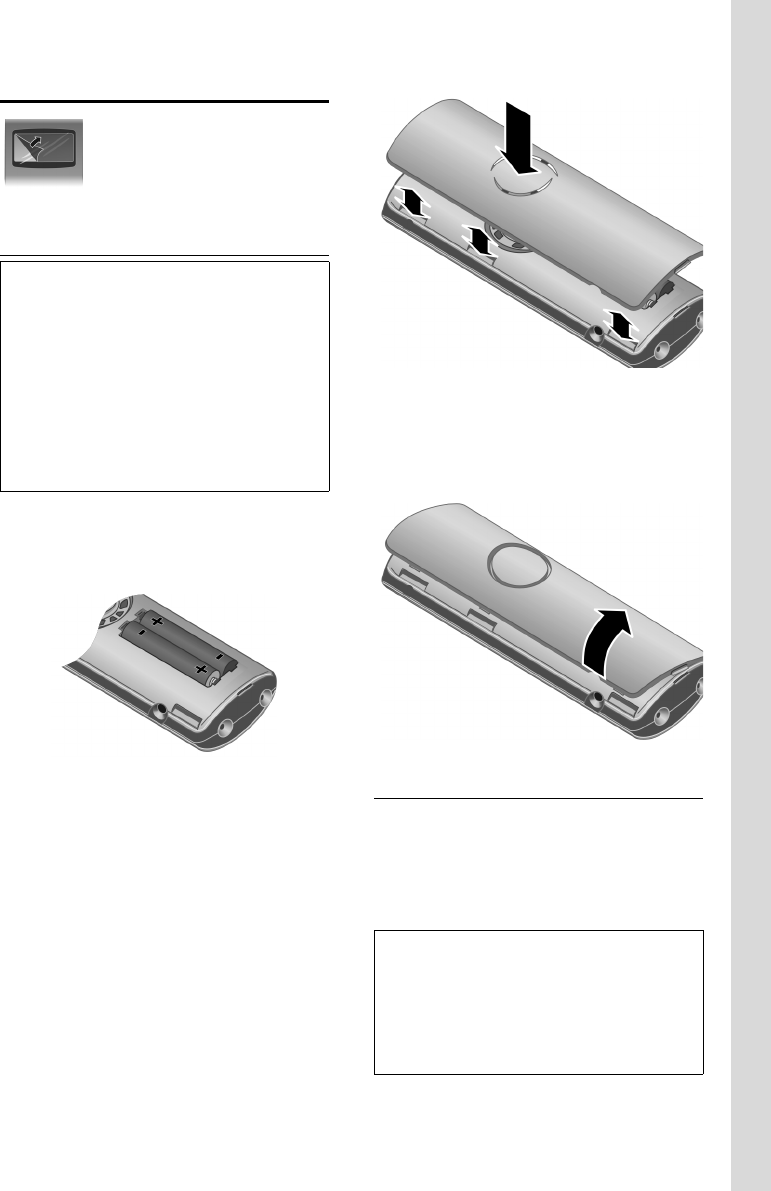
6
First Steps
Gigaset S450 IP / EN-Master / A31008-M1713-B121-1-43 / starting.fm / 7.9.06
Version 4, 16.09.2005
Setting up the handset for use
The display is protected by a
plastic film. Please remove
the protective film!
Inserting the batteries
¤Insert the batteries the right way round
(see figure).
The polarity is indicated in/on the battery
compartment.
The handset turns on automatically.
You will hear a confirmation tone.
Closing the battery cover
¤First, align the notches on the side of
the battery cover with the protrusions
on the inside of the housing.
¤Then press the cover until it clicks into
place.
Opening the battery cover
¤If fitted, remove the belt clip.
¤Place your finger in the headset socket
cavity and pull the battery cover
upwards.
Connecting the charging cradle
Connecting up the charging cradle and
mounting it on the wall (if required) is
described at the end of this user guide.
¤To charge the batteries, leave the hand-
set in the charging cradle.
Warning:
Use only the rechargeable batteries recom-
mended by Siemens on page 38! This means
that you must not use conventional (non-
rechargeable) batteries or other battery types,
otherwise serious damage to health and prop-
erty cannot be ruled out, e.g. the outer casing
of the batteries could be destroyed or the bat-
teries could explode. The phone could also
malfunction or be damaged as a result of using
batteries that are not of the recommended
type.
Notes:
– Only place the handset in the charging cra-
dle that is intended for it.
– If the handset has turned itself off because
the batteries are flat and if it is then placed
in the charging cradle, it will turn itself on
automatically.

7
First Steps
Gigaset S450 IP / EN-Master / A31008-M1713-B121-1-43 / starting.fm / 7.9.06
Version 4, 16.09.2005
Initial charging and discharging of
batteries
Battery charging is indicated in the top
right of the display by a flashing battery
icon e, V or U. During handset oper-
ation, the battery icon indicates the
charge status of the batteries (page 1).
The correct charge status can only be dis-
played when the batteries are first fully
charged and discharged through use.
¤To do this, leave the handset in the
charging cradle without interruption
until the battery icon stops flashing in
the display (approx. 13 hours).
¤Once the batteries are fully charged,
remove the handset from the charging
cradle and do not put it back again until
the batteries are fully discharged.
Please note:
uAlways repeat the charging and dis-
charging procedure if you remove the
batteries from the handset and reinsert
them.
uThe batteries may warm up as they are
charging. This is not dangerous.
uAfter a while the charge capacity of the
batteries will decrease for technical rea-
sons.
Setting the date and time
If the date and time are not yet set on the
phone, the display key §Time§ is displayed.
You can set the date and time later via the
menu v ¢ÐSettings ¢Date/Time.
¤Press §Time§ or open the menu.
¤Change multiple line input:
Date:
Enter day, month and year in 6-digit
format.
Time:
Enter hours and minutes as 4 digits
(e.g. Q M 1 5 for 7:15 a.m.
§Save§ Press the display key.
The date and time are shown in the hand-
set's idle display (page 1).
Registering the handset to the base
station
Your handset is registered to the base sta-
tion by default.
Instructions on how to register further
handsets to the base station and make
free internal phone calls is described in
the detailed user guide on the Internet at
www.siemens.com/gigaset.
Installing the base station
The base station is designed for use in
closed, dry rooms with a temperature
range of +5°C to +45°C.
¤Set up or wall-mount the base station
at a central point in the apartment or
house.
Please note:
uNever expose the phone to heat
sources, direct sunlight or other electri-
cal appliances.
uProtect your Gigaset from moisture,
dust, corrosive liquids and vapours.
Note:
After the first battery charge and discharge,
you may replace your handset in the charging
cradle after every call.
Note:
You will find explanations for the icons and
typographical conventions used in this user
guide in the detailed user guide for your
Gigaset S450 IP on the Internet at
www.siemens.com/gigaset.
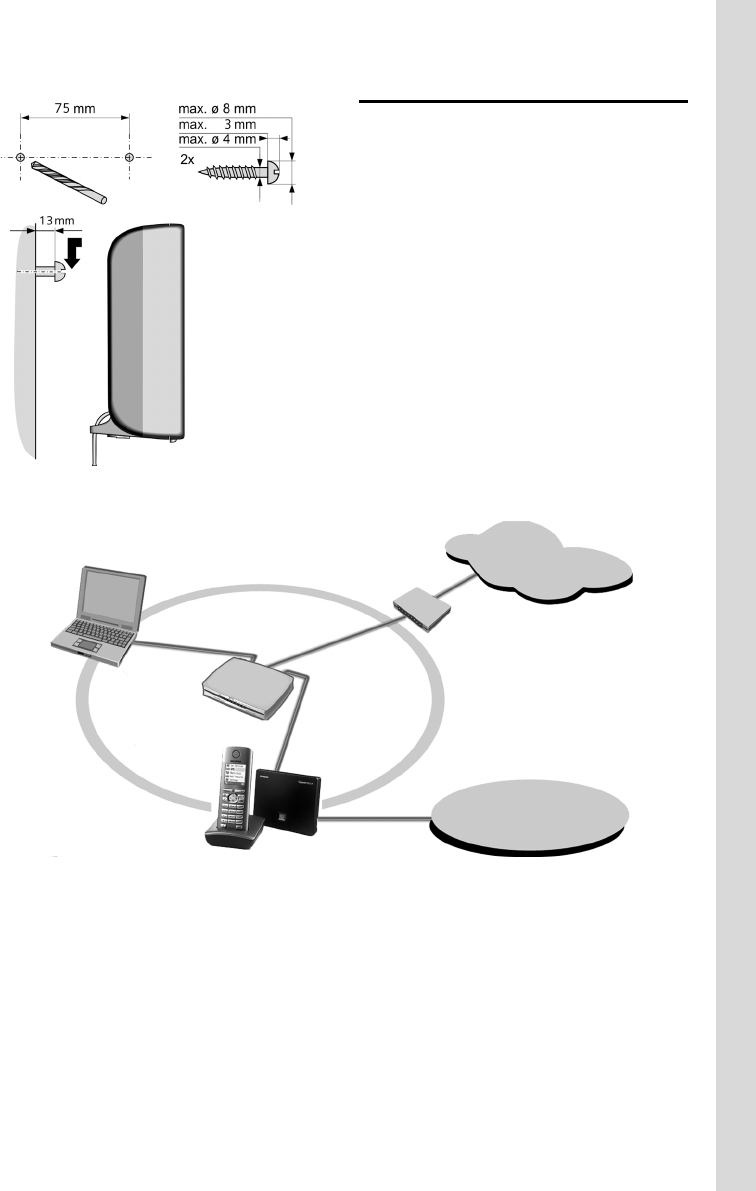
8
First Steps
Gigaset S450 IP / EN-Master / A31008-M1713-B121-1-43 / starting.fm / 7.9.06
Version 4, 16.09.2005
Wall mounting the base station Connecting the base station
In order to be able to make calls with your
phone via the fixed network and via VoIP,
you must connect the base station to
the fixed network and the Internet, see
Figure 1.
1 Internet connection:
router and modem (illustrated) or
router with integrated modem
2 Gigaset S450 IP base station
3 Gigaset S45 handset
4PC in LAN
Follow the steps in the order given below:
1. Connect the base station with the
phone connection
2. Connect the base station with the
mains power supply
3. Connect the base station with the rout-
er
Figure 1 Connecting the phone to the fixed network and the Internet
Internet
Fixed network
1
1
2
LAN
4
3
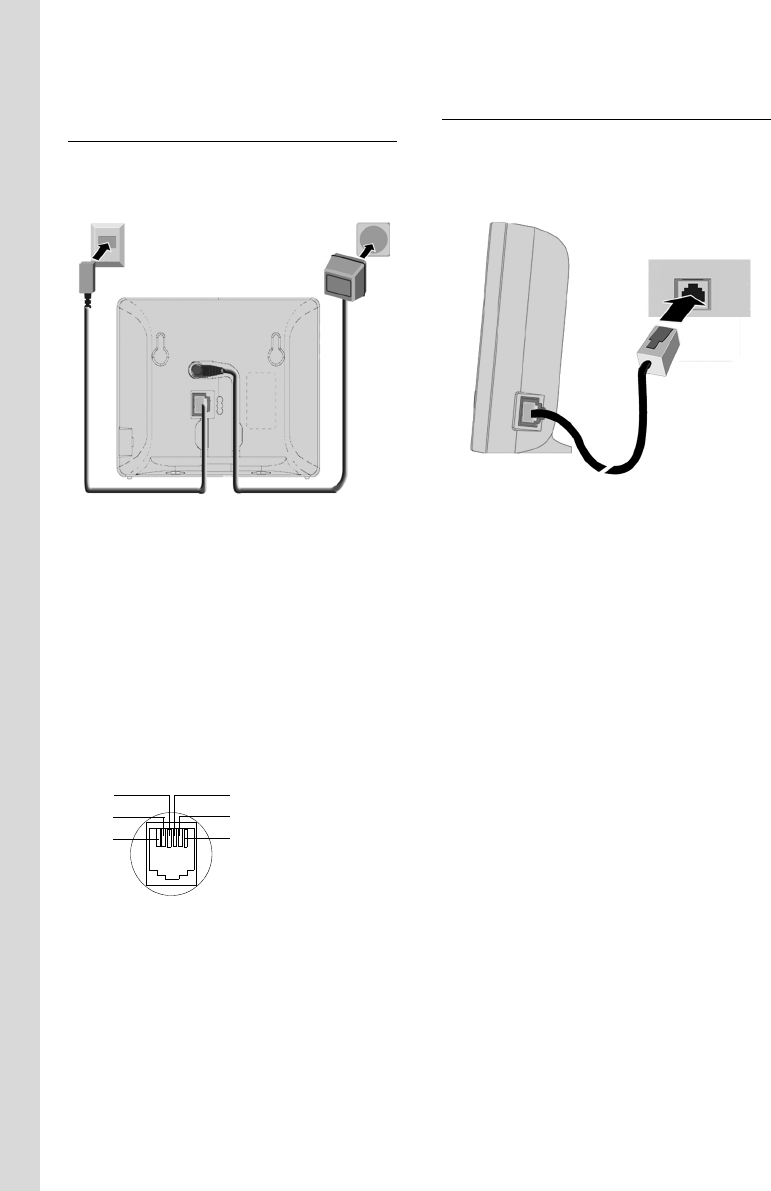
9
First Steps
Gigaset S450 IP / EN-Master / A31008-M1713-B121-1-43 / starting.fm / 7.9.06
Version 4, 16.09.2005
Connecting the base station with the
fixed network and the mains power
supply
¤Please first connect the phone jack
and then the mains adapter, as shown
below.
1 Phone jack with phone cord
2 Underside of the base station
3 Mains adapter 230 V
Please note:
uKeep the mains adapter plugged in at
all times for operation, as the phone
does not work without mains connec-
tion.
uIf you buy a replacement phone cord
from a retailer, ensure that the phone
jack is connected correctly.
You can now use your phone to make calls
via the fixed network and can be reached
at your fixed network number!
Connecting the base station with the
router
For Internet access you need a router con-
nected to the Internet via a modem (if nec-
essary, this can be integrated in the
router).
1 Side view of the base station
2 Network plug (LAN) with network cable
3 Router network plug
As soon as the cable connecting the
phone and router is plugged in, the paging
key lights up on the front of the base
station (page 1).
Correct phone jack assignment
1unused
2unused
3a
4b
5unused
6unused
13
2
3
2
1
4
5
6
1
2
3
3
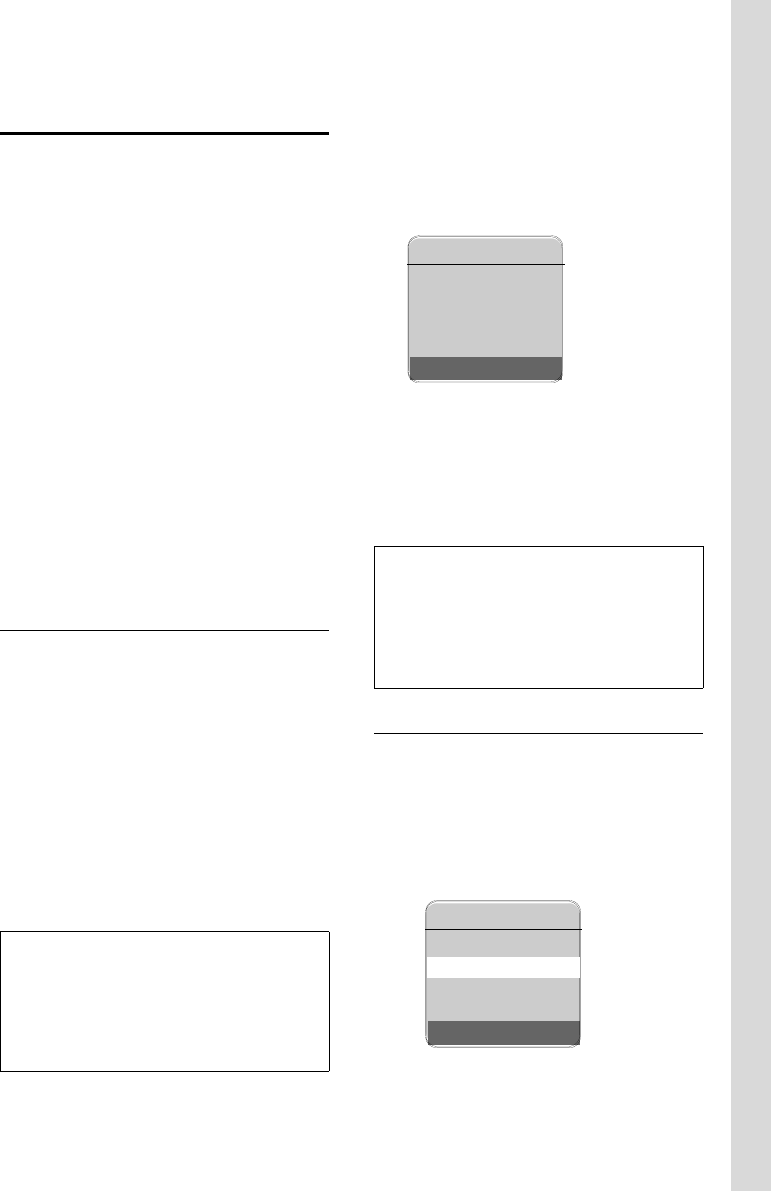
10
First Steps
Gigaset S450 IP / EN-Master / A31008-M1713-B121-1-43 / starting.fm / 7.9.06
Version 4, 16.09.2005
Making settings for VoIP
telephony
Before you can use the Internet (VoIP) to
phone any other users on the Internet, the
fixed network or the mobile phone net-
work, you need the services of a VoIP pro-
vider who supports the VoIP SIP standard.
Precondition: You have registered
(e.g. via your PC) with such a VoIP provider
and set up at least one VoIP account.
The following phone settings are neces-
sary in order for you to use VoIP. You will
receive all information from your VoIP pro-
vider.
uYour user name with the VoIP provider,
if this is required by the VoIP provider
uYour registration name
uYour password with the VoIP provider
uVoIP provider general settings
The connection assistant will help you
with the settings.
Starting the connection assistant
Precondition: The base station is con-
nected to the mains power supply and the
router. Your router is connected to the
Internet (page 9).
Tip: If VoIP is activated as the default
connection for your phone (default set-
ting page 29), the phone will attempt to
make a direct connection to the server
belonging to your VoIP provider after the
connection assistant is closed. If incorrect/
incomplete information means that the
connection cannot be made, messages
will be displayed (page 11).
As soon as the handset battery is suffi-
ciently charged, the message key f on
the handset will flash (around 20 minutes
after you have put the handset in the
charging cradle). Press the message key
f to start the connection assistant.
You will see the following display:
§Yes§ Press the display key to start
the connection assistant.
The settings are carried out in
several steps.
~Enter system PIN (the default
setting is "0000").
Downloading VoIP provider data
The phone establishes a connection with
the Siemens server on the Internet. Pro-
files with general access data for various
VoIP providers can be downloaded here.
After a short time the following is dis-
played:
qSelect country (press up/down
on the control key) and press
Note:
Your phone is preconfigured for dynamic
assignment of the IP address. In order for your
router to "recognise" the phone, dynamic IP
address assignment must also be activated on
the router, i.e. the router's DHCP server is acti-
vated.
Note:
The connection assistant will also start auto-
matically if you try to establish a connection
via the Internet, before you have made the
necessary settings.
You can also call up the connection assistant at
any time via the menu (page 13).
Connection Assist.
Start assistant
for entry of VoIP
connection data?
No Yes
Select Country
Germany
England
France
Netherlands, the
ÝOK
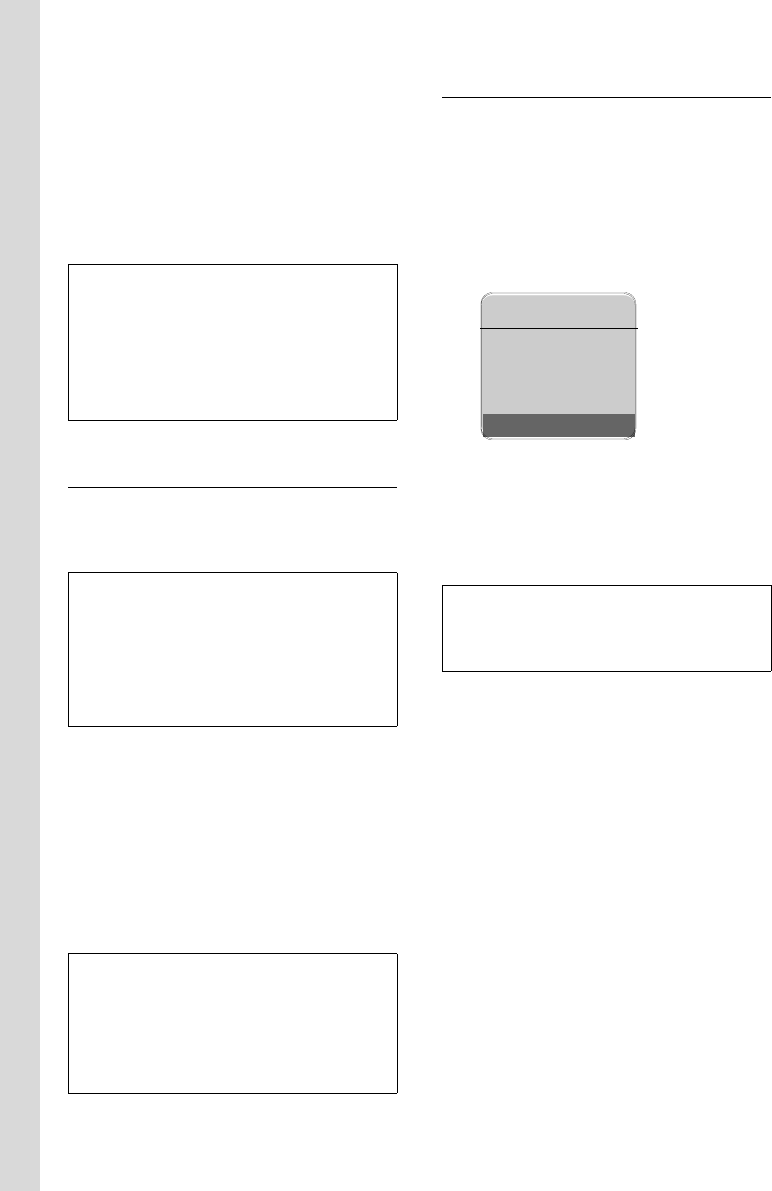
11
First Steps
Gigaset S450 IP / EN-Master / A31008-M1713-B121-1-43 / starting.fm / 7.9.06
Version 4, 16.09.2005
§OK§. The VoIP providers are
shown for which VoIP profiles
are available.
qSelect your VoIP provider and
press §OK§.
The necessary general access data for your
VoIP provider is downloaded and saved on
the phone.
Entering user data for your first
VoIP account
Enter the VoIP user data for the first VoIP
account. Your VoIP provider will supply
you with this data.
Username:
If this is required by your pro-
vider, enter the user name and
press §OK§.
Authent. Name:
Enter the registration name
and press §OK§.
Authent. Password:
Enter password and press §OK§.
Completing the VoIP settings
Once you have made all the necessary
entries, the message "Connection data com-
plete" is displayed. The handset returns to
idle status.
If all the settings are correct and if the
phone can make a connection to the VoIP
server, then the internal name of the
handset will be displayed (example):
You can now use your phone to make calls
via the fixed network (fixed line) and the
Internet! Callers can reach you on your
fixed network number and your VoIP
number!
No connection to the Internet/VoIP server
If one of the following messages is dis-
played instead of the internal name after
the connection assistant is closed, then a
fault has occurred:
Server not accessible!
The phone has no connection to the Inter-
net.
¤Check the cable connection between
the base station and the router (the
LED on the base station must light up)
and the connection between the router
and the Internet connection.
¤Check whether the phone is connected
to the LAN. It might not have been pos-
sible to assign an IP address to the
phone or the IP address has already
been assigned to another LAN sub-
scriber and cannot be changed.
If the data for your VoIP provider is not offered
as a download, press the display key ”.
You can then carry out the following steps as
instructed by the connection assistant.
You must then make the necessary settings for
the VoIP provider with the Web configurator
(page 31). Your VoIP provider will supply you
with this data.
Using the Web configurator, you can later
enter three further VoIP accounts (VoIP phone
numbers) set up with the same VoIP provider.
Your phone can then (together with your fixed
network number) be reached under up to five
different phone numbers. You can assign the
phone numbers to individual handsets regis-
tered with the base station (page 30).
Note:
Please note when making these entries that
the VoIP user data is case sensitive. When
entering text, the first letter is capitalised as
standard. Press and hold the # key if neces-
sary to switch between upper/lower case text
and numerical entry.
Note:
To ensure that you can always be reached via
the Internet, the router must be permanently
connected to the Internet.
ÐV
INT 1
10.08.06 09:45
FixedLine IP

12
First Steps
Gigaset S450 IP / EN-Master / A31008-M1713-B121-1-43 / starting.fm / 7.9.06
Version 4, 16.09.2005
¤Find the IP address using the hand-
set menu:
v ¢ÐSettings ¢Base
¢Local Network
¤Start the Web configurator with the
IP address.
¤If no connection can be established,
change the settings on the router
(activate DHCP server) or the
phone's IP address.
Provider registration failed!
uYour personal data for registering with
the VoIP provider may have been
entered incompletely or incorrectly.
¤Check your entries for Username,
Authent. Name and Authent. Password.
Particularly check your use of upper
and lower case.
To do this, open the following menu
on your handset:
v ¢ÐSettings ¢Telephony
¢VoIP ¢Provider Registr.
uThe server address for the VoIP server
has not yet been entered, or has been
entered incorrectly.
¤Start the Web configurator.
¤Open Settings ¢Telephony
¢Connections Web page.
¤Edit the server address where neces-
sary.
Note:
If port forwarding is activated on your router
for the ports that have been registered as the
SIP port (Standard 5600) and the RTP port
(Standard 5004), then it makes sense to switch
off DHCP and assign the phone a static IP
address (otherwise you may not be able to
hear the other party during VoIP calls):
– Via the handset menu:
v ¢ÐSettings ¢Base
¢Local Network
Or
– Via the Web configurator:
¥Open Settings ¢IP configuration
Web page.
¥Select IP address type.
Please note that the IP address and subnet
mask depend on the router's address block.
You must also specify the default gateway and
DNS server. The IP address for the router is
generally entered here.
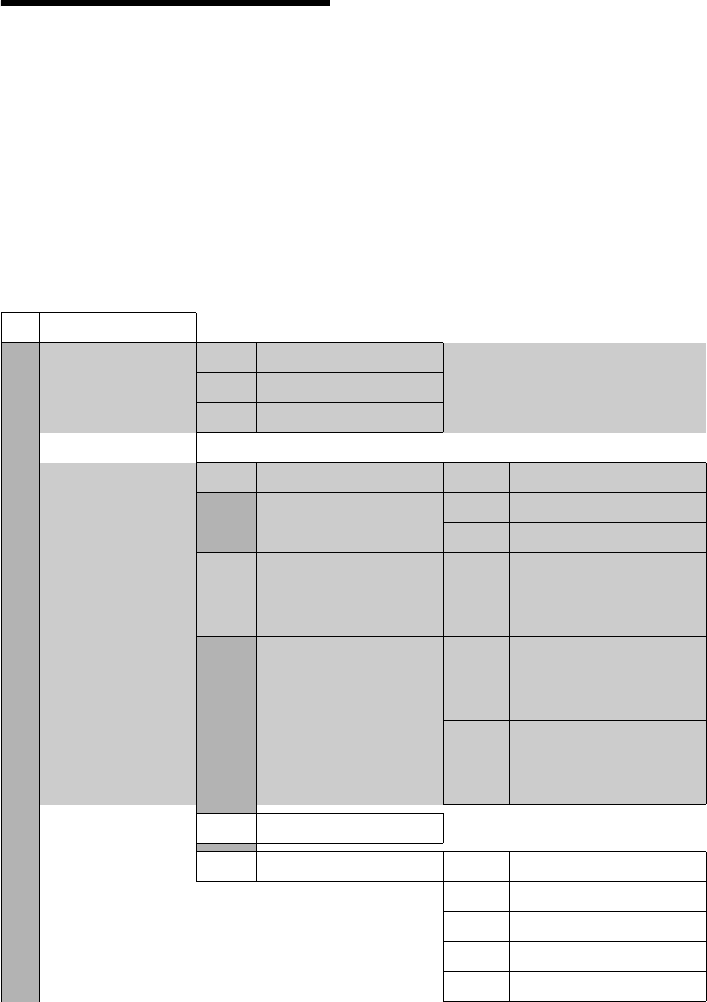
13
Menu tree
Gigaset S450 IP / EN-Master / A31008-M1713-B121-1-43 / menuetree.fm / 7.9.06
Version 4, 16.09.2005
Menu tree
To open the main menu for your phone, with the handset in idle status, press on the right
of the control key: v.
There are two ways to select a function:
Using number combinations ("shortcut")
¤Enter the number combination that is in front of the function in the menu tree.
Example: v 541 for "Set handset language".
Scrolling through the menus
¤Scroll to the function with the control key q (press up and down) and press §OK§.
1 î Messaging
1-1 SMS An SMS mailbox (general or private) activated without a PIN
1-1-1 New SMS
1-1-2 Incoming (0)
1-1-3 Outgoing (0)
An SMS mailbox with a PIN or 2-3 mailboxes activated
1-1-1 Mailbox 1-1-1-1 New SMS
1-1-1-2 Incoming (0)
1-1-1-3 Outgoing (0)
1-1-2
to
1-1-4
Mailbox 1
Mailbox 2
Mailbox 3
1-1-2-1
to
1-1-4-1
New SMS
1-1-2-2
to
1-1-4-2
Incoming (0)
1-1-2-3
to
1-1-4-3
Outgoing (0)
1-1-5 SMS Service
1-1-6 Settings 1-1-6-1 Service Centres
1-1-6-2 SMS Mailboxes
1-1-6-3 Notify Number
1-1-6-4 Notify Type
1-1-6-5 Status Report
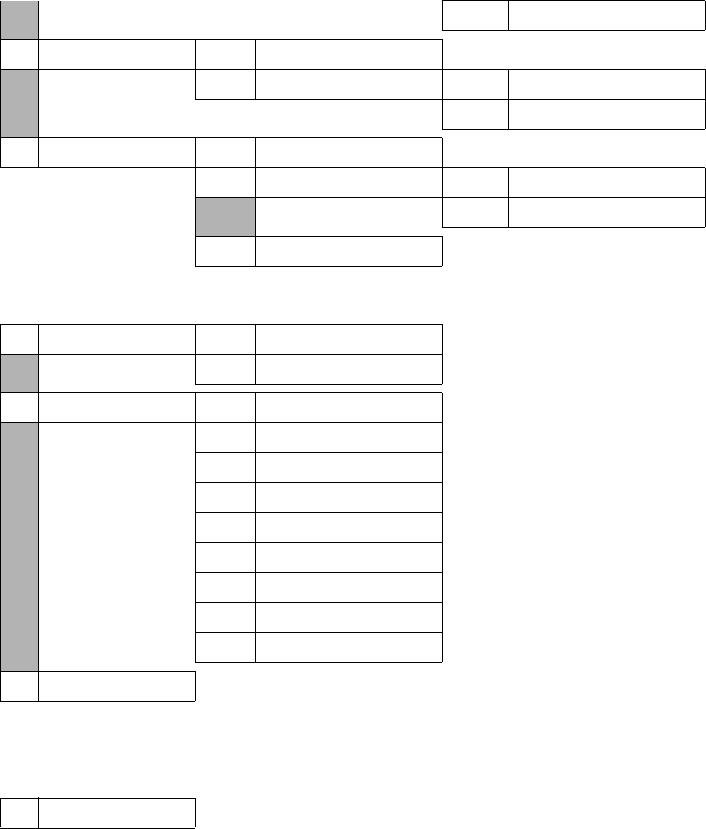
14
Menu tree
Gigaset S450 IP / EN-Master / A31008-M1713-B121-1-43 / menuetree.fm / 7.9.06
Version 4, 16.09.2005
1-1-6-6 Subscribe to SMS
1-2 E-mail 1-2-1 Inbox (0)
1-2-2 Settings 1-2-2-1 Registration
1-2-2-2 Incoming (POP3)
1-3 Messenger 1-3-1 Buddies
1-3-2 User Status 1-3-2-1 Change Status
1-3-2-2 Info
1-3-3 Messages
2 êSel. Services
2-1 VoIP 2-1-6 Call Divert
2-1-7 Call Waiting
2-2 Fixed Line 2-2-1 Withhold No.
2-2-2 Send Number
2-2-3 Call Waiting Off
2-2-4 Automatic Recall
2-2-5 Call Divert
2-2-6 Call Waiting
2-2-7 Parallel Ringing
2-2-8 Call Protection
2-2-9 Unknown Call Rej.
2-3 Ringback Off
3 ìAlarm Clock
4 íAdd. Features
4-3 Room Monitor
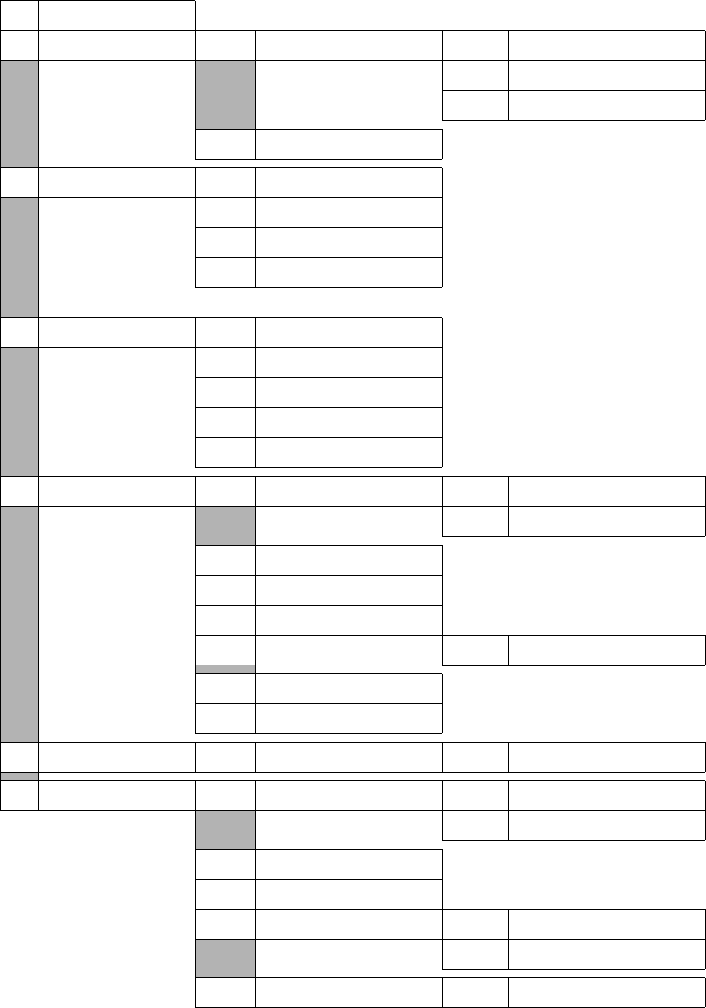
15
Menu tree
Gigaset S450 IP / EN-Master / A31008-M1713-B121-1-43 / menuetree.fm / 7.9.06
Version 4, 16.09.2005
5 ÐSettings
5-1 Date/Time
5-2 Audio Settings 5-2-1 Ringer Settings 5-2-1-1 Ext. Calls
5-2-1-2 Internal Calls
5-2-1-3 All
5-2-2 Advisory Tones
5-3 Display 5-3-1 Screen Picture
5-3-2 Colour Scheme
5-3-3 Contrast
5-3-4 Backlight
5-4 Handset 5-4-1 Language
5-4-2 Auto Answer
5-4-3 Register H/Set
5-4-4 Select Base
5-4-5 Reset Handset
5-5 Base 5-5-1 Calls List Type 5-5-1-1 Missed Calls
5-5-1-2 All Calls
5-5-2 Music on hold
5-5-3 System PIN
5-5-4 Base Reset
5-5-5 Add. Features 5-5-5-1 Repeater Mode
5-5-6 Local Network
5-5-8 Software Update
5-6 Voice Mail 5-6-1 Set Key 1 5-6-1-1 Network Mailb.
5-7 Telephony 5-7-1 Default Line 5-7-1-1 VoIP
5-7-1-2 Fixed Line
5-7-2 Connection Assist.
5-7-3 Area Code
5-7-5 Fixed Line 5-7-5-1 Dialling Mode
5-7-5-2 Recall
5-7-6 VoIP 5-7-6-1 Show Stat. on HS

16
Menu tree
Gigaset S450 IP / EN-Master / A31008-M1713-B121-1-43 / menuetree.fm / 7.9.06
Version 4, 16.09.2005
5-7-6-2 Select Provider
5-7-6-3 Provider Registr.
Not all menu items are described in this quick guide. You will find the full description in the
detailed user guide for your Gigaset S450 IP on the Internet at www.siemens.com/gigaset.

17
Making calls with VoIP and the fixed network
Gigaset S450 IP / EN-Master / A31008-M1713-B121-1-43 / telephony.fm / 7.9.06
Version 4, 16.09.2005
Making calls with VoIP and
the fixed network
Making an external call
External calls are those that are made via
the public telephone network (fixed net-
work) or the Internet (VoIP). You deter-
mine what type of connection you want to
use when you dial.
Selecting the type of connection via the
talk key and making a call
~c/d
Enter number/IP address and
briefly press/press and hold
the talk key or handsfree key.
A default connection is established on
your phone (fixed network or VoIP,
page 30).
¤Press the talk key c or handsfree key
d briefly if you want to make the
call via the default connection.
¤Press and hold the talk key c or
handsfree key d if you want to make
the call via the other type of connec-
tion.
Selecting the type of connection via
display keys and making a call
Precondition: §FixedLine§ and/or §IP§ are
assigned to the display keys on your hand-
set (Gigaset S45 default setting).
§FixedLine§ / §IP§
Press the display key to select
the type of connection.
~/sEnter number or select
number from the directory.
c/ dPress the talk or handsfree key.
Entering an IP address
Via VoIP you can dial an IP address instead
of a phone number.
¤Press the star key * to separate the
parts of the IP address
(e.g. 149*246*122*28).
¤If necessary, press the hash key # to
attach the SIP port number of the per-
son you are calling to the IP address
(e.g. 149*246*122*28#5060).
Cancelling the dialling operation
You can cancel the dialling operation with
the end call key a.
Ending a call
aPress the end call key.
Notes:
– You can make two parallel external calls
on your base station (on two handsets):
two calls via VoIP or one call each via VoIP
and the fixed network.
– If you use VoIP to make a call to the fixed
network, you may also have to dial the area
code for local calls (depending on the VoIP
provider).
To avoid always having to enter the area
code for local calls, you can also enter the
area code in the configuration (with the
Web configurator, see page 30). It will then
be inserted automatically for local calls.
Note:
If you use a different GAP-compatible handset
to the Gigaset S45, all calls will be made via the
standard connection, even if you press and
hold the talk key c. If you want to use the
non-default connection to make a call, enter a
star (*) at the end of the number.
Note:
If you have assigned several VoIP phone num-
bers to your phone, for each handset you can
set which VoIP number (account) is to be used
for calls (handset send number, page 30).

18
Making calls with VoIP and the fixed network
Gigaset S450 IP / EN-Master / A31008-M1713-B121-1-43 / telephony.fm / 7.9.06
Version 4, 16.09.2005
Accepting a call
The handset indicates an incoming call by
ringing and by the flashing handsfree
key d. The display shows the caller's
number or name and the receive number
the caller is calling (e.g. for Fixed Line, for
IP1 etc.).
You can accept the call by:
¤Pressing the talk key c.
¤Pressing the display key §Accept§.
¤Pressing the handsfree key d.
If the handset is in the charging cradle and
the Auto Answer function is activated
(page 15), the handset will take a call
automatically when you lift it out of the
cradle.
Switching between earpiece and
handsfree mode
¤Press handsfree key d to activate/
deactivate handsfree mode during a
call.
If you wish to place the handset in the
charging cradle during a call in handsfree
mode:
¤Press and hold the handsfree key d
while placing the handset in the charg-
ing cradle. If the handsfree key d
does not light up, press the key again.
Dialling emergency numbers
The default setting for your phone is that
all numbers that are saved as emergency
numbers are automatically dialled via the
fixed network.
You can deactivate this function via the
Web configurator (see dialling plans,
page 31) (e.g. if you use the phone with-
out a fixed network). Ask beforehand,
however, whether your VoIP provider sup-
ports emergency numbers.
Emergency numbers have already been
set in your phone. You can use the
Web configurator to view these and enter
more emergency numbers.
Note:
The handset will only indicate calls to receive
numbers assigned to the handset (page 30).
If no specific receive numbers are assigned, all
calls are signalled on all handsets.
Please note: If you have used Web configura-
tor to deactivate the function Emergency calls
always via fixed line and then entered an auto-
matic local area code for VoIP calls (Web page
Settings £Telephony £Dialing Plans, page 31),
then the local area code will also be inserted
before emergency numbers if they are dialled
using VoIP.
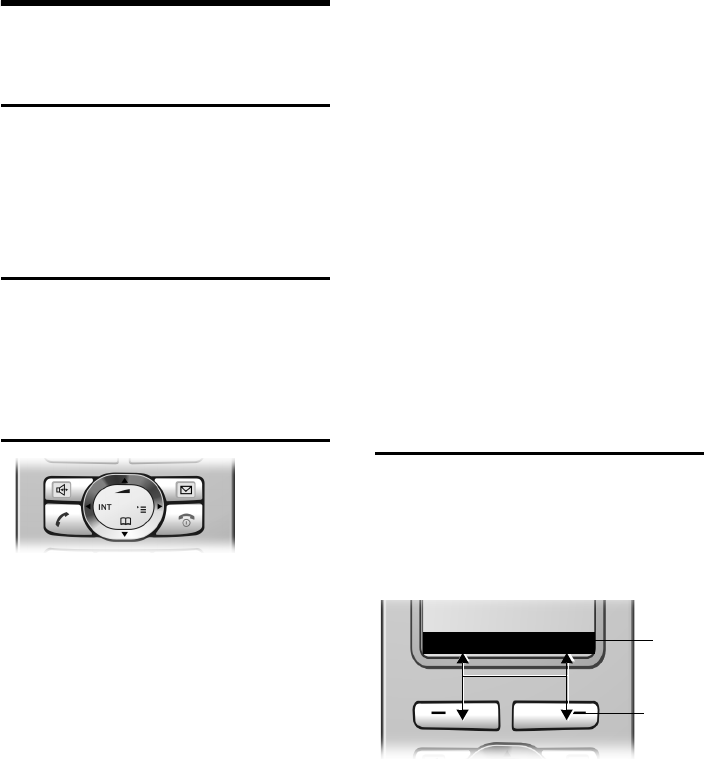
19
Operating the handset
Gigaset S450 IP / EN-Master / A31008-M1713-B121-1-43 / telephony.fm / 7.9.06
Version 4, 16.09.2005
Operating the handset
Activating/deactivating the
handset
aPress and hold the end call
key.
You will hear the confirmation tone.
Activating/deactivating the
keypad lock
#Press and hold the hash key.
You will hear the confirmation tone. The
Ø icon appears in the display when the
keypad lock is activated.
Control key
In this user guide, the side of the control
key that you must press in the given oper-
ating situation is shown in black. Example:
t for "press up on the control key".
The control key has the following func-
tions:
When the handset is in idle status
s Open directory .
v Open main menu.
u Open list of handsets.
tAdjust the ringtone volume of
the handset (page 28).
In lists and menus
t/ s Scroll up/down line by line.
v Open submenu or confirm
selection.
u Go back one menu level or
cancel.
In an input field
You can use the control key to move the
cursor up t, down s, right v or
left u.
During an external call
s Open the directory.
u Initiate an internal consulta-
tion call.
tAdjust the loudspeaker vol-
ume for operation in earpiece/
handsfree mode.
Display keys
The current display functions are shown in
the bottom display line in reversed high-
lights. The function of the display keys
changes depending on the particular
operating situation.
Example:
1 Current display key functions are shown in
the bottom display line.
2 Display keys
2
1
FixedLine IP

20
Operating the handset
Gigaset S450 IP / EN-Master / A31008-M1713-B121-1-43 / telephony.fm / 7.9.06
Version 4, 16.09.2005
Reverting to idle status
Reverting to idle status from anywhere in
the menu:
¤Press and hold the end call key a.
Or:
¤Do not press any key: after 2 minutes
the display will automatically revert to
idle status.
Changes that you have not confirmed or
saved by pressing §OK§, §Yes§, §Save§, §Send§ or
Save §OK§ will be lost.
You will find more information about
operating your Gigaset S45 in the
detailed user guide on the Internet at
www.siemens.com/gigaset.

21
Using the directory and lists
Gigaset S450 IP / EN-Master / A31008-M1713-B121-1-43 / directories_charges.fm / 7.9.06
Version 4, 16.09.2005
Using the directory and lists
The options are:
uDirectory, call-by-call list
uLast number redial list
uSMS, e-mail and messenger lists
uCalls list
Directory
You can save up to 150 numbers and
names in the directory.
¤Open the directory by briefly pressing
the s key in idle status.
Length of an entry
Number: max. 32 digits
Name: max. 16 characters
Saving a number in the directory
s ¢New Entry
¤Change multiple line input:
Number:
Enter number.
Name:
Enter name.
Annivers.:
Press the display key §Edit§ and enter the
date, reminder time and type of signal.
Speed Dial:
Select the digit keys for speed dial
(Q, 2 to O).
The number is dialled via the non-
default connection if you press and
hold the assigned digit key in idle sta-
tus.
¤Save changes with §Save§.
Managing directory entries
s ¢s(Select entry)
¤Press the display key §View§ to view the
entry
Or
¤Press the display key §Options§ to open
the directory menu.
You can use the directory menu to, e.g.:
uChange entries, delete entries, mark
entries as a VIP (Very Important Per-
son) or send them to other handsets
connected to the base station
uDelete the directory or send it to
another handset
You will find additional information in
the detailed user guide for your
Gigaset S450 IP on the Internet at
www.siemens.com/gigaset.
Last number redial list
The last number redial list contains the ten
numbers last dialled with the handset.
cBriefly press the talk key to
open the last number redial
list.
Notes:
Always enter the phone number with a dialling
code. You will need this if you want to call a
fixed network subscriber via VoIP.
Alternatively, you can also specify an area code
via the Web configurator that is placed before
all numbers dialled without a dialling code.
Note:
If you add a star (*) to the end of the number,
the number will be dialled via the non-default
connection (page 29), even if you briefly press
the talk key c.

22
Using the directory and lists
Gigaset S450 IP / EN-Master / A31008-M1713-B121-1-43 / directories_charges.fm / 7.9.06
Version 4, 16.09.2005
Opening lists with the
message key
You can open the following lists with the
message key f:
uSMS list
If several mailboxes are set up, several
lists are displayed where applicable.
uIncoming e-mail list
The list is only displayed if there are
new messages in the mailbox on the
incoming e-mail server.
uMessenger message list
The list is only displayed on the online
handset.
uNetwork mailbox
If your network provider supports this
function and the network mailbox is set
up for fast access via key 1 (page 15).
uCalls list
You can configure your calls list to
include all calls or just missed calls.
v ¢ÐSettings ¢Base
¢Calls List Type
An advisory tone sounds as soon as a new
message arrives in a list. The f key
flashes (it goes off when the key is
pressed). In idle status, the display shows
an icon for the new message.
The number of new entries is shown
beneath the corresponding icon.
If you press the f key, the lists contain-
ing messages will be displayed (exception:
network mailbox). Lists with new mes-
sages are displayed in bold.
Opening a list
f ¢If necessary, select the list
qSelect entry.
You will find additional information about
the lists in the detailed user guide for your
Gigaset S450 IP on the Internet at
www.siemens.com/gigaset.
Dialling from the directory/list
¤Open the directory/list.
¤Select entry via q.
¤Press and hold/briefly press the talk
key c (page 17).
Note:
Your calls list will only save calls made to the
receiving numbers assigned to your handset
(page 30).
Icon New message...
à ... in network mailbox
Á ... in calls list
À ... in SMS, messenger or e-mail
list
Note:
You can only dial IP addresses via VoIP.

23
SMS (text messages)
Gigaset S450 IP / EN-Master / A31008-M1713-B121-1-43 / sms_BRD_neutral.fm / 7.9.06
Version 4, 16.09.2005
SMS (text messages)
Your unit is supplied ready for you to send
SMS messages immediately.
When an SMS is sent, the base station
automatically establishes a connection via
the fixed network.
Preconditions:
uCalling Line Identification is enabled for
your fixed network connection.
uYour network provider supports SMS in
the fixed network (information on this
can be obtained from your network
provider).
uYou are registered with your service
provider to send and receive SMS.
Writing/sending/saving an SMS
v ¢îMessaging ¢SMS
¢(mailbox, mailbox PIN)
New SMS Select and press §OK§.
~Write an SMS.
§Options§ Press the display key.
Save Select and press §OK§.
The message is stored in the
draft message list. You can
edit and send it later.
Open the draft message list:
v ¢îMessaging ¢SMS
¢(mailbox, mailbox PIN)
¢Outgoing
Or
Send Select and press §OK§.
SMS Select and press §OK§.
s/ ~
Select number with area code
(even if you are in that area)
from the directory or enter
directly. If necessary, add the
mailbox ID to the end of the
number.
§Options§ Press the display key.
Send Select and press §OK§.
Linking SMS messages
If an SMS contains more than 160 charac-
ters or large image data, it is sent (up to
eight messages) and received as a linked
SMS.
When writing an SMS you will see the fol-
lowing displayed in the top right of the
header (example):
Note:
When you call up the SMS menu for the first
time, you are automatically registered with
accessible SMS centres for which you have
entered numbers. You can then receive SMS
messages from these SMS centres.
You can enter more SMS centres and use the
registration wizard to register with these SMS
centres. Please refer to the detailed user guide
for your Gigaset S450 IP on the Internet at
www.siemens.com/gigaset.
Note:
You can also send an SMS as a fax or as an e-
mail to an e-mail address. You must enter the
e-mail address at the beginning of the SMS
message. For further information, please refer
to the detailed user guide on the Internet at
www.siemens.com/gigaset.
Please note that linking SMS messages gener-
ally results in higher charges.
SMS 1170(2)
1 Maximum number of characters you
may still write or add (it is assumed that
there are 8 linked SMS messages)
2 Number of SMS messages that have
had to be linked for the text written so
far.
2
1

24
SMS (text messages)
Gigaset S450 IP / EN-Master / A31008-M1713-B121-1-43 / sms_BRD_neutral.fm / 7.9.06
Version 4, 16.09.2005
Receiving/reading an SMS
All received SMS messages are saved in
the incoming message list. Linked SMS
messages are displayed as one message.
If this is too long or has not transferred
completely, it will be split into individual
messages.
New SMS messages are signalled on all
Gigaset S45 handsets by the À icon in the
display, the flashing message key f
and an advisory tone.
Opening the incoming message list
¤Press message key f and if neces-
sary select mailbox and enter mailbox
PIN.
Or
¤Open menu v ¢îMessaging
¢SMS ¢(mailbox, mailbox PIN)
¢Incoming.
Reading an SMS
¤Press the display key §Read§.
Managing SMS lists
Via the options in the incoming/draft mes-
sage list you can, for example:
uDelete individual SMS messages or the
entire list
uForward or reply to an SMS
uContinue writing and send SMS mes-
sages stored in the draft message list.
¤Select the SMS and press §Options§.
Notification by SMS
When out and about, you can arrange to
be notified about missed calls by SMS.
Storing the notification number
v ¢îMessaging ¢SMS ¢Settings
¢Notify Number
¤Enter the number of a mobile phone or
another device with SMS functionality
to which the notification is to be sent.
(Warning: Do not enter your own land-
line number!)
Activating notification
v ¢îMessaging ¢SMS ¢Settings
¢Notify Type
¤Set On if you want SMS notification.
¤Save with §Save§.
You will find further information in
the detailed user guide for your
Gigaset S450 IP on the Internet at
www.siemens.com/gigaset.
Please note that your network provider usu-
ally charges for SMS notifications.

25
E-mail notifications
Gigaset S450 IP / EN-Master / A31008-M1713-B121-1-43 / email.fm / 7.9.06
Version 4, 16.09.2005
E-mail notifications
Your phone will inform you when new e-
mail messages have arrived in your incom-
ing e-mail server.
Periodically (approx. every 15 min.) it
establishes a connection to the e-mail
server and checks whether new messages
are present.
New e-mail messages are indicated on all
registered Gigaset S45 handsets by an
advisory tone and by a flashing message
key f. The À icon is shown in the idle
display.
Preconditions:
uYou have established an e-mail account
with an Internet provider.
uThe incoming e-mail server uses the
POP3 protocol.
uYou have stored the name of the
incoming e-mail server and your per-
sonal access data (account name, pass-
word) in the phone.
Entering access data for the
incoming e-mail server
Entering access data
v ¢îMessaging ¢E-mail ¢Settings
¢Registration
¤Change multiple line input:
Username:
Enter user name (account name)
(max. 32 characters).
Authent. Password:
Enter password (this is case sensitive).
¤Press the display key §Save§.
Entering the incoming e-mail server
v ¢îMessaging ¢E-mail ¢Settings
¢Incoming (POP3)
¤Enter the name of the incoming e-mail
server (POP3 server).
¤Select §Options§ ¢Save and press §OK§.
Opening the incoming
message list
v ¢îMessaging ¢E-mail ¢Inbox
Or, if there are new e-mail messages
(the message key f flashes):
f ¢E-mail:
The phone establishes a connection to the
incoming e-mail server. The list of e-mail
messages stored there is displayed.
The sender's name and e-mail address
(single line, abbreviated if necessary) are
displayed as well as the date and time.
Viewing the header of an e-mail
qSelect e-mail entry.
§Subject§ Press display key.
The subject of the e-mail message
(max. 120 characters) is displayed.
” Now press the display key to
return to the incoming mes-
sage list.
Viewing the sender's address for an e-mail
qSelect e-mail entry.
§From§ Press the display key.
The sender's e-mail address is displayed in
full.
”Now press the display key to
return to the incoming mes-
sage list.

26
Messenger
Gigaset S450 IP / EN-Master / A31008-M1713-B121-1-43 / messenger.fm / 7.9.06
Version 4, 16.09.2005
Messenger
The messenger on your phone makes
instant messaging possible (immediate
message transfer, chatting). The phone
supports XMPP messenger (Jabber).
When you go online (page 26), you have
the following options:
uDisplay your list of contacts (buddies)
on your handset. Each buddy's status is
shown, e.g. online and ready to chat
(state of presence, see page 26).
uExchange messages with your buddies.
The message key f on your handset
will flash and a beep will sound to alert
you to new messages.
uCall your buddies directly from the
buddy list (page 27).
Preconditions for instant messaging:
uYou have registered with an instant
messaging provider via the Web
browser on your PC and have created
a buddy list.
uYou have saved the messenger server
address and your messenger server
access data (user ID, password) via the
Web configurator on your phone
(page 31).
Establishing a connection,
going online
v ¢ îMessaging ¢Messenger
§Yes§ Confirm prompt.
If you are online, the messenger submenu
is displayed on the screen. You can open
your buddy list, send and receive mes-
sages and call buddies.
Opening the buddy list and
chatting
Precondition: You are Online.
v ¢ îMessaging ¢Messenger
¢ Buddies
q Select a buddy.
In the buddy list, the buddies are sorted
according to their status (see below). Sta-
tus is displayed by the colour of the % icon:
1. Online / Ready for chat (green)
2. Away / Extended Away / Do not disturb
(orange)
3. Offline / Invisible (red)
If the buddy's status changes, the buddy
list is updated. If a buddy changes to
Online / Ready for chat status, a message is
displayed.
Checking information about buddies
§Info§ Press the display key.
Chatting to buddies
§Chat§ Press the display key.
¤Write and send your message
(page 27).
Note:
If your instant messaging provider does not
support the messenger client on your phone,
open an account with a Jabber server and
enter its address using the Web configurator in
your phone. Many of these Jabber servers
offer gateways to other messenger servers
(e.g. AOL, ICQ, MSN, Yahoo!).
You will find a list of Jabber servers and an
overview of the gateways to other messenger
servers on the Internet at:
http://www.jabber.org.
Notes
– Only one of the handsets connected to the
base station can go online.
– An external call for your handset interrupts
the chat, but you remain online. Once the
call is ended or rejected, you can resume
your chat.

27
Messenger
Gigaset S450 IP / EN-Master / A31008-M1713-B121-1-43 / messenger.fm / 7.9.06
Version 4, 16.09.2005
Receiving messages
Precondition: You are Online.
New messages are signalled by the mes-
sage key f flashing, a beep sounding
and the À icon being displayed in the idle
display.
The messages are stored in the Messenger:
message list.
Opening the message list
f ¢Messenger: (2)
Or:
v ¢î Messaging ¢Messenger
¢ Messages
Reading the message
¤Press q to select the message.
¤Press the display key §Read§.
You have the following options:
§Delete§ Delete the message.
Or:
§Answer§ Reply to the message
(page 27).
The message list is deleted as soon as you
go offline.
Writing/sending messages
Precondition: You have pressed §Chat§ in
the buddy list or §Answer§ when reading a
buddy message.
¤Enter the message.
¤Select §Menu§ ¢Send and press §OK§.
The message is sent to the buddy.
¤Press §OK§ to return to the buddy or mes-
sage list.
When writing a message, you can activate/
deactivate predictive text, select the input
language for predictive text or delete the
text via §Menu§.
Calling a buddy
Precondition:
uThe messenger server supports calls via
vCard and the buddy's vCard contains a
phone number.
uYou have selected a buddy from the
buddy list or the message list
cBriefly press/press and hold
the talk key (page 17).
The first number found in the vCard is
selected.
Disconnecting, going offline
v ¢ îMessaging ¢Messenger
¢User Status ¢Change Status
¤Select Offline status and press §OK§.
¤Confirm the security prompt with §Yes§.
The messenger message list is deleted.
The buddy list is no longer available.
Note:
You cannot reply to info messages (special pro-
vider information).

28
Handset/base station settings
Gigaset S450 IP / EN-Master / A31008-M1713-B121-1-43 / settings_bs_hs_pabx.fm / 7.9.06
Version 4, 16.09.2005
Handset/base station
settings
The handset and base station are precon-
figured, but you can change these settings
to suit your individual requirements. You
will find the relevant functions in the sub-
menus
v ¢Settings and v ¢ Alarm Clock
(page 13).
The base station settings are carried out
using a registered Gigaset S45 handset.
Changing the handset display
keys
You can assign different functions to your
handset's display keys. The change is
handset-specific.
¤In idle status, press and hold the right
or left display key (e.g. §FixedLine§).
The list of possible key assignments is
opened.
qSelect a function and press
§OK§.
The handset returns to idle status. The
labelling for the display key has changed
(e.g. §Messgr.§ if Messenger is selected).
Adjusting the loudspeaker
volume
You can set the loudspeaker volume for
handsfree talking to five different levels
and the earpiece volume to three different
levels. You can only make these adjust-
ments during a call. The handsfree talking
volume can only be adjusted when this
function is set.
You are conducting an external call.
tOpen menu.
r Select volume.
§Save§ Press display key if necessary
to save the setting perma-
nently.
If t is assigned with another function,
e.g. toggling:
§Options§ Open menu.
Volume Select and press §OK§.
Configure setting (see above).
Setting ringtones
Set the volume and melody depending on
the type of signalling required.
v ¢Ð Settings ¢Audio Settings
¢ Ringer Settings
Ext. Calls / Internal Calls / All
Select and press §OK§.
¤Change multiple line input:
rSet volume (1–6).
sScroll to the next line.
rSelect melody.
§Save§ Press the display key to save
the setting.
In idle status, you can also open the Ringer
Settings menu by pressing t briefly.
Activating/deactivating the ringtone
You can deactivate the ringtone on your
handset before you accept a call or when
the handset is in idle status; the ringtone
can be deactivated permanently or just for
the current call. The ringtone cannot be
re-activated while an external call is in
progress.
Deactivating the ringtone permanently
*Press the star key and hold
until you can no longer hear
the ringtone.
The Ú icon appears in the display.
Re-activating the ringtone
*Press and hold the star key.

29
Handset/base station settings
Gigaset S450 IP / EN-Master / A31008-M1713-B121-1-43 / settings_bs_hs_pabx.fm / 7.9.06
Version 4, 16.09.2005
Deactivating the ringtone for the current
call
§Silence§ Press the display key.
Activating/deactivating advisory
tones
v ¢Ð Settings ¢Audio Settings
¢ Advisory Tones
¤Change multiple line input:
Key Tones: / Confirm.:
Select On or Off.
Battery:
Select On, Off or In Call. The battery
warning tone is only activated/deacti-
vated and only sounds during a call.
¤Save changes with §Save§.
Setting the alarm clock
Precondition: The date and time have
already been set (page 7).
Activating/deactivating the alarm
clock and setting the wake-up time
v ¢ìAlarm Clock
¤Change multiple line input:
Activation:
Select On or Off.
Time:
Enter the wake-up time in 4-digit for-
mat.
Melody:
Select melody.
Volume:
Set the volume (1-6).
¤Save changes with §Save§.
You will see the ¼ icon.
When the alarm clock rings ...
Alarm repeat after 5 minutes
§Snooze§ Press the display key or any
key.
After the second repetition the wake-up
call is deactivated for 24 hours.
Deactivating the alarm clock for 24 hours
§OFF§ Press the display key. The
wake-up call is deactivated.
Changing the system PIN on
the base station
You can change the base station's 4-digit
default system PIN ("0000") to a 4-digit
system PIN known only to yourself.
v ¢ÐSettings ¢Base ¢System PIN
~Enter the current system PIN
and press §OK§.
~ Enter the new system PIN.
sScroll to the Re-enter PIN: line.
~Now re-enter the new system
PIN and press §OK§.
For security reasons, "****" is displayed
instead of the system PIN.
a Press and hold (idle status).
Setting default connection
You can make settings according to
whether you want to make calls via VoIP or
fixed network by default (press talk key
briefly).
v ¢ÐSettings ¢Telephony
¢Default Line
VoIP / Fixed Line
Select and press §OK§ (½=on).
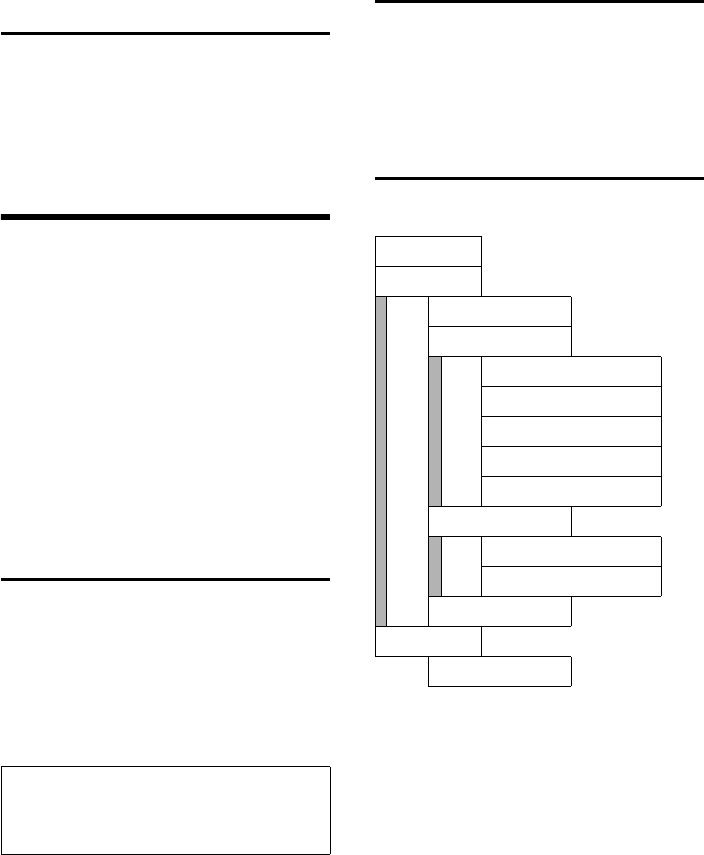
30
Web configurator
Gigaset S450 IP / EN-Master / A31008-M1713-B121-1-43 / settings_bs_hs_pabx.fm / 7.9.06
Version 4, 16.09.2005
Checking the base station
MAC address
In idle status:
v55O2Q
The base station MAC address is displayed.
aPress and hold (idle status).
Web configurator
The Web configurator is the Web interface
for your handset. It allows you to make the
settings for your phone's base station via
your PC's Web browser.
Preconditions:
uA standard Web browser is installed on
the PC, e.g. Internet Explorer version
6.0 or higher, or Firefox version 1.0.4 or
higher.
uThe phone and PC are connected to
each other via a router.
Connecting the PC to the Web
configurator
¤Launch the Web browser on your PC.
¤Enter the phone's IP address into the
address field of the Web browser,
e.g. http://192.168.1.2.
¤Press the return key.
A connection is established to the phone's
Web configurator.
De-registering
In the menu bar at the top right of every
Web page in the Web configurator, you
will see the Log Off command. Click on
Log Off to de-register from the Web config-
urator.
Web configurator functions
Menu tree
Settings
With the Web configurator on your phone
you have the following options:
uIP configuration
Configure your phone access to the
local network (IP address, gateway to
the Internet).
Especially if you assign your phone a
static IP address, you must enter the
gateway and DNS server via the Web
configurator. That is usually your
router.
Note:
You can check the phone's current IP address
on the handset:
v ¢ÐSettings ¢Base ¢Local Network
Home (Function overview)
Settings
IP configuration
Telephony
Connections
Number assignment
DTMF
Dialing Plans
Directory
Messaging
Messenger
E-Mail
Miscellaneous
Status (Information about the phone)
Device

31
Web configurator
Gigaset S450 IP / EN-Master / A31008-M1713-B121-1-43 / settings_bs_hs_pabx.fm / 7.9.06
Version 4, 16.09.2005
uTelephony ¢Connections
Configure your phone for VoIP.
Download your VoIP provider's general
access data from the Internet onto your
phone or enter the data yourself.
Enter the personal access data of up to
four VoIP accounts (VoIP phone num-
bers) with this VoIP provider.
Activate/deactivate these VoIP phone
numbers as required.
The phone registers with the VoIP
server using the activated VoIP phone
numbers and can be reached under
these numbers.
uTelephony ¢Number assignment
Assign each registered handset its own
VoIP phone numbers as send and
receive numbers (page 30).
State which handsets are to ring when
calls are made to your fixed network
number.
uTelephony ¢DTMF
DTMF signalling is required e.g. to
check and control some network mail-
boxes.
Specify how DTMF signals are to be
transmitted for VoIP. In RTP packets
(such as voice data) or in SIP info pack-
ets.
Ask your VoIP provider which DTMF sig-
nalling is supported.
uTelephony ¢Dialing Plans
You can activate and deactivate the fol-
lowing dialling plans:
– For VoIP calls, an area code is auto-
matically attached in front of all
numbers that do not start with 0.
Specify this dialling code.
– Stored emergency numbers are
always dialled via the fixed network.
The stored emergency numbers are
displayed. You can enter a phone
number of your own.
uTelephony ¢Directory
Store your outlook contacts in a tsv file
on your PC and load this onto your
handset. The contacts are copied to the
handset directory.
Back up the directories for your hand-
sets on a PC.
uMessaging
Enter the access data for your messen-
ger server and your e-mail server.
You can specify a resource name your
phone should use to log on to the mes-
senger server as well as a priority for
message delivery. If you are online and
using more than one device, any mes-
sage from a buddy will be sent to the
device that has the highest priority.
uMiscellaneous
State whether you wish to receive
information about new firmware ver-
sions on the Internet.
For the following firmware update you
can specify the server/PC that is to
make the update, and if required load
new firmware onto the phone.
View the VoIP status codes on the
handset to diagnose problems with
VoIP connections.
You will find the description of the
Web configurator in the detailed user
guide for your Gigaset S450 IP on the
Internet at www.siemens.com/gigaset.

32
Appendix
Gigaset S450 IP / EN-Master / A31008-M1713-B121-1-43 / appendix.fm / 7.9.06
Version 4, 16.09.2005
Appendix
Care
¤Wipe down the base station and hand-
set with a damp cloth (no solvents) or
an antistatic cloth.
Never use a dry cloth. This can cause a
build up of static.
Contact with liquid
If the handset has come into contact with
liquid:
¤Switch the handset off and remove
the batteries immediately.
¤Allow the liquid to drain from the hand-
set.
¤Pat all parts dry, then with the battery
compartment open and the keypad fac-
ing down place the handset in a dry,
warm place for at least 72 hours (not
in a microwave, oven etc.).
¤Do not switch on the handset again
until it is completely dry.
When it has fully dried out, you will nor-
mally be able to use it again.
Questions and answers
If you have any questions about using
your phone, visit us at
www.siemens.com/gigasetcustomercare
at any time. You will also find a list of com-
mon problems and possible solutions in
the detailed user guide.
FCC / ACTA Information
Warning: Changes or modifications to this unit not
expressly approved by Siemens Cordless Products
could void the FCC authority to operate the equipment.
This includes the addition of any external antenna
device.
This equipment complies with Part 68 of the FCC rules
and the requirements adopted by the ACTA. On the
bottom of the base station is a label that contains,
among other information, a product identifier in the
format US:AAAEQ##TXXXX. If requested, this number
must be provided to the telephone company.
A plug and jack used to connect this equipment to the
premises wiring and telephone network nust comply
with the applicable FCC Part 68 rules and requirements
adopted by the ACTA. A compliant telephone cord and
modular plug is provided with this product. It is
designed to be connected to a compatible modular
jack that is also compliant. See installation instruc-
tions for details.
The REN is used to determine the number of devices
that may be connected to a telephone line. Excessive
RENs on a telephone line may result in the devices not
ringing in response to an incoming call. In most but not
all areas, the sum of RENs should not exceed five (5.0).
To be certain of the number of devices that may be
connected to a line, as determined by the total RENs,
contact the local telephone company. For products
approved after July 23, 2001, the REN for this product
is part of the product identifier that has the format
US:AAAEQ##TXXXX. The digits represented by ## are
the REN without a decimal point (
e.g.
, 03 is a REN of
0.3). For earlier products, the REN is separately shown
on the label.
If this equipment causes harm to the telephone
network, the telephone company will notify you
in
advance, that temporary discontinuance of service
may be required. But if advance notice isn’t practical,
the telephone company will notify the customer as
soon as possible. Also, you will be advised of your right
to file a complaint with the FCC if you belive it is
necessary.
The telephone company may make changes in its
facilities, equipment, operations or procedures that
could affect the operation of the equipment. If this
happens the telephone company will provide advance
notice in order for you to make necessary modifica-
tions to maintain uninterrupted service. If you experi-
ence trouble with this telephone system, disconnect it
from the network until the problem has been corrected
or until you are sure that the equipment is not malfunc-
tioning.
Please address any questions about the
DSL and cable connection to your Inter-
net provider.
!
33
Appendix
Gigaset S450 IP / EN-Master / A31008-M1713-B121-1-43 / appendix.fm / 7.9.06
Version 4, 16.09.2005
If trouble is experienced with this equipment, for repair
or warranty information, please contact Siemens
Customer Care, Tel. 1-888-777-0211. If the equipment is
causing harm to the telephone network, the telephone
company may request that you disconnect the equip-
ment until the problem is resolved. This equipment is
of a type that is not intented be repaired by the
Customer (user).
This telephone system may not be used on coin ser-
vice provided by the telephone company. Connection
to party line service is subject to state tariffs. Contact
the state public utility commission, public service
commission or corporation commission for informa-
tion. Privacy of communications may not be ensured
when using this phone.
If your home has specially wired alarm equipment
connected to the telephone line, ensure the installa-
tion of this equipment does not disable your alarm
equipment. If you have questions about what will
disable alarm equipment, consult your telephone
company or a qualified installer.
This telephone system equipment has been tested
and found to comply with the limits for Class B digital
device, pursuant to Part 15 of the FCC Rules.
Operation is subject to the following two conditions:
(1) This device may not cause harmful interference,
and (2) This device must accept any interference
received, including interference that may cause
undesired operation. These limits are designed to
provide reasonable protection against harmful inter-
ference in a residential installation. Some cordless
telephones operate at frequencies that may cause
interference to nearby TV’s and VCR’s; to minimize or
prevent such interference, the system base should not
be placed near or on top of a TV or VCR; and, if inter-
ference is experienced, moving the base farther away
from the TV or VCR will often reduce or eliminate
the interference.
However, there is no guarantee that interference will
not occur in a particular installation. If this telephone
system does cause harmful interference to radio or
television reception, which can be determined by turn-
ing the system off and on, the user is encouraged to try
to correct the interference by one or more of the fol-
lowing measures:
1. Reorient or relocate the receiving antenna.
2. Increase the separation between the base station
and receiver.
3. Connect the base station into an outlet on a circuit
different from that to which the receiver is connected.
4. Consult the dealer or an experienced radio TV
technician for help.
Notice for Direct Inward Dialing ("DID")
ALLOWING THIS EQUIPMENT TO BE OPERATED IN
SUCH A MANNER AS TO NOT PROVIDE FOR PROPER
ANSWER SUPERVISION AS A VIOLATION OF PART 68
OF THE FCC‘S RULES.
Notice to Hearing Aid Wearers:
This phone system is compatible with inductively cou-
pled hearing aids.
Power Outage:
In the event of a power outage, your cordless
telephone will not operate. The cordless telephone
requires electricity for operation. You should have a
telephone that does not require electricity available
for use during power outages.
Notice:
The installation of the base unit should allow at least
8 inches between the base and persons to be in
compliance with FCC RF exposure guidelines.
For body worn operation, the portable part (handset)
has been tested and meets FCC RF exposure guide-
lines. Use with an accessory that contains metal parts
may not ensure compliance with FCC RF exposure
guidelines.
Notice to telephone company service:
If you need service from your telephone company,
please provide them with the information
– Facility interface Code (FIC)
– Service Order Code (SOC)
– Universal Service Order Code (USOC) Jack
as indicated on the label on the bottom side of the
base station.

34
Safety precautions
Gigaset S450 IP / EN-Master / A31008-M1713-B121-1-43 / appendix.fm / 7.9.06
Version 4, 16.09.2005
Industry Canada Certification
Operation is subject to the folowing two conditions (1)
this device may not cause interference, and (2) this
device must accept any interference, including inter-
ference that may cause undesired operation of the
device.
NOTICE: The Industry Canada label identifies certified
equipment. This certification means that the equip-
ment meets certain telecommunications network,
protective, operational and safety requirements as
prescribed in the appropriate Terminal Equipment
Technical Requirements document(s). The Depart-
ment does not guarantee the equipment will operate
to the user’s satisfaction.
Before installing this equipment, users should ensure
that it is permissible to be connected to the facilities of
the local telecommunications company. The equip-
ment must also be installed using an acceptable
method of connection. The customer should be aware
that compliance with the above conditions may not
prevent degradation of service in some situations.
Repairs to certified equipment should be coordinated
by a representative designated by the supplier.
Any repairs or alterations made by the user to this
equipment, or equipment malfunctions, may give the
telecommunications company cause to request the
user to disconnect the equipment.
Users should ensure for their own protection that
the electrical ground connections of the power utility,
telephone lines and internal metallic water pipe
system, if present, are connected together.
This precaution may be particularly important in rural
areas
NOTE: Users should not attempt to make such connec-
tions themselves, but should contact the appropriate
electric inspection authority, or electrician, as appro-
priate.
This product meets the applicable Industry Canada
technical specifications.
The Ringer Equivalence Number is an indication of the
maximum number of devices allowed to be connected
to a telephone interface. The termination of an inter-
face may consist of any combination of devices
subject only to the requirement that the sum of the
RENs of all devices does not exceed five.
Safety precautions
Before using your telephone equipment, basic safety
instructions should always be followed to reduce the
risk of fire, electric shock and injury to persons.
1. Read and understand all instructions.
2. Follow all warnings and instructions marked on the
product.
3. Unplug this product from the wall telephone jack
and power outlet before cleaning. Do not use liquid
cleaners or aerosol cleaners. Use damp cloth for
cleaning.
4. Do not use this product near water, for example,
near a bathtub, wash bowl, kitchen sink, or laundry
tub, in a wet basement or near a swimming pool.
5. Place this product securely on a stable surface.
Serious damage and/or injury may result if the unit
falls.
6. Slots or openings in the cabinet and the back and
bottom are provided for ventilation, to protect it from
overheating. These openings must not be blocked or
covered. This product should never be placed near or
over a radiator or heat register, or in a place where
proper ventilation is not provided.
7. This product should be operated only from the type
of power source indicated on the marking label. If you
are not sure of the type of power supply to your home,
consult your dealer or local power company.
8. Do not place objects on the power cord. Install the
unit where no one can step or trip on the cord.
9. Do not overload wall outlets and extension cords as
this can result in the risk of fire or electric shock.
10. Never push objects of any kind into this product
through cabinet slots as they may touch dangerous
voltage points or short out parts that could result in the
risk of fire or electric shock. Never spill liquid of any
kind on this product.
11. To reduce the risk of electric shock or burns, do not
disassemble this product. Take it to a qualified service
center when service is required. Opening or removing
covers may expose you to dangerous voltages, dan-
gerous electrical current or other risks. Incorrect reas-
sembly can cause electric shock when the appliance
is subsequently used.
12. Unplug the product from the wall outlet and refer
servicing to qualified service personnel under the fol-
lowing conditions:
a.) When the power cord is damaged or frayed.
b.) If liquid has been spilled into the product.
c.) If the product has been exposed to rain or water.
35
Safety precautions
Gigaset S450 IP / EN-Master / A31008-M1713-B121-1-43 / appendix.fm / 7.9.06
Version 4, 16.09.2005
d.) If the product does not operate normally by follow-
ing the operating instructions. Adjust only those controls
that are covered by the operating instructions because
improper adjustment of other controls may result in
damage and may require extensive work by a qualified
technician to restore the product to normal operation.
e.) If the product has been dropped or physically has
been damaged.
f.) If the product exhibits a distinct change in perfor-
mance.
13. Avoid using a telephone (other than a cordless
type) during a thunderstorm. There may be a remote
risk of electrical shock from lightning. Therefore we
suggest a surge arrestor.
14. Do not use the telephone to report a gas leak in the
vicinity of the leak.
15. Emergency/911 numbers may not be dialed if the
keypad is locked.
BATTERY SAFETY PRECAUTIONS
To reduce the risk of fire, injury or electric shock, and
to properly dispose of batteries, please read and
understand the following instructions.
CONTAINS ALKALINE NICKEL METAL HYDRIDE
BATTERY. BATTERY MUST BE RECYCLED OR DIS-
POSED OF PROPERLY. DO NOT DISPOSE OF IN
MUNICIPAL WASTE.
1. Only use the batteries specified for use with this
product.
2. DO NOT USE ALKALINE NICKEL CADMIUM OR
ALKALINE LITHIUM BATTERIES, or mix batteries
of different sizes or from different manufacturers
in this product. DO NOT USE NONRECHARGEABLE
BATTERIES.
3. Do not dispose of the batteries in a fire; the cells may
explode. Do not expose batteries to water. Check with
local codes for special disposal instructions.
4. Do not open or mutilate the batteries. Released
electrolyte is corrosive and may cause damage to the
eyes or skin. The electrolyte may be toxic if swallowed.
5. Exercise care in handling the batteries in order not
to short the batteries with conducting materials such
as rings, bracelets, and keys. The batteries or conduct-
ing material may overheat and cause burns or fire.
6. Charge the batteries provided with, or identified for
use with, this product only in accordance with the
instructions and limitations specified in the user’s
manual. Do not attempt to charge the batteries with
any means other than that specified in the users
manual.
7. Periodically clean the charge contacts on both the
charger and handset.
36
Safety precautions
Gigaset S450 IP / EN-Master / A31008-M1713-B121-1-43 / appendix.fm / 7.9.06
Version 4, 16.09.2005
Customer Care Warranty for Cordless Products
To obtain Siemens Customer Care Warranty service,
product operation information, or for problem resolution, call:
Toll Free: 1-888-777-0211
9:00 a.m. – 8:00 p.m. Central Standard Time seven days a week
www.siemens.com/gigasetcustomercare
Limited Warranty
This limited, non-transferable warranty is provided to
the original purchaser. The product is warranted to be
free from defects in materials and workmanship under
normal installation, use, and service for period of
one (1) year from the date of purchase as shown
on the purchaser’s receipt.
Our obligation under this warranty is limited to repair
or replacement (at our option) of the product or any
part(s), that are defective, provided that the product
is returned to Siemens during the warranty period.
A copy of the dated purchase receipt must accompany
products returned. In the absence of a purchase
receipt, the warranty period shall be one (1) year from
the date of manufacture. Repair or replacement of the
product is your sole and exclusive remedy.
If the product is repaired, reconditioned component
parts or materials may be used. If the product is
replaced, we may choose to replace it with a new or
reconditioned product of the same or similar design.
The repaired or replacement product will be war-
ranted for either (a) 90 days or (b) the remainder of the
original one (1) year warranty period, whichever is
longer. Batteries are warranted to be free from defects
at the time of purchase.
EXCLUSIONS: This warranty does not cover (a) the
adjustment of customer-operated controls as
explained in the appropriate model’s instruction
manual, or (b) the repair of any product, which has
been altered or defaced. This warranty shall not apply
to the cabinet or cosmetic parts, antenna, buttons,
batteries, or routine maintenance. This warranty does
not apply to repairs or replacements necessitated by
any cause beyond the control of SIEMENS including,
but not limited to, any malfunction, defect or failure
caused by or resulting from unauthorized service or
parts, improper maintenance, damage from leaking
batteries, operation contrary to furnished instructions,
shipping or transit accidents, modification or repair by
the user, abuse, misuse, neglect, accident, incorrect
line voltage, fire, floor or other Acts of God, or normal
wear and tear.
This warranty shall be void if the product is damaged
as a result of defacement, misuse, abuse, neglect,
accidents, destruction, or alteration of the serial
number, improper electrical voltages or currents,
repair, alteration or maintenance by any person or
party other than our authorized service facility or
any violation of instructions furnished by us.
The warrantor is not liable for incidental or conse-
quential damages resulting from the use of this
product, or arising out of any breach of this limited
warranty. (As examples, this excludes damages for
lost time, lost calls or messages, cost of having some-
one remove or re-install an installed unit if applicable,
travel to and from servicer. The items listed are not
exclusive, but are for illustration only.)
This warranty is also void if this product is removed
from the country in which the original purchaser
purchased it, if it is used in a country, which it not
registered for use, or if it is used in a country for which
it was not designed. Due to variations in telephone
systems and communications laws, this product may
be illegal for use in some countries. We assume no
responsibility for damages or penalties incurred
resulting from the use of this product in a manner
or location other than that for which it is intended.
37
Safety precautions
Gigaset S450 IP / EN-Master / A31008-M1713-B121-1-43 / appendix.fm / 7.9.06
Version 4, 16.09.2005
THIS ONE-YEAR LIMITED WARRANTY IS IN LIEU OF
ALL OTHER WARRANTIES EXPRESS OR IMPLIED.
ANY IMPLIED WARRANTIES, INCLUDING BUT NOT
LIMITED TO THE IMPLIED WARRANTIES OF MER-
CHANTABILITY AND FITNESS FOR A PARTICULAR
PURPOSE, SHALL BE LIMITED IN DURATION TO THE
ONE-YEAR DURATION OF THIS WRITTEN LIMITED
WARRANTY. EXCEPT AS EXPRESSLY SET FORTH
HEREIN, WE DISCLAIM ANY LIABILITY FOR DAM-
AGES ARISING FROM OWNERSHIP, USE, OR LOSS OF
USE OF THE PRODUCTS, LOSS OF TIME, INCONVE-
NIENCE, INJURY TO CUSTOMER OR ANY OTHER PER-
SON, OR DAMAGE TO CUSTOMER PROPERTY
CAUSED BY THE PRODUCT, LOSS OF REVENUE OR
PROFIT, OR DAMAGES FOR ANY FAILURE TO PER-
FORM. IN NO EVENT SHALL WE BE LIABLE FOR ANY
SPECIAL, INCIDENTAL, PUNITIVE OR CONSEQUEN-
TIAL DAMAGES EVEN IF WE ARE ADVISED OF THE
POSSIBILITY OF SUCH DAMAGES. IN NO EVENT
SHALL SIEMENS’ LIABILITY EXCEED THE COST OF
REPAIRING OR REPLACING THE DEFECTIVE PROD-
UCT AS PROVIDED HEREIN, AND ANY SUCH LIABILI-
TIES WILL TERMINATE UPON EXPIRATION OF THE
WARRANTY PERIOD.
Some states do not allow limitations on how long an
implied warranty lasts, or the exclusion or limitation of
incidental or consequential damages, so the above
limitations may not apply to you.
This limited warranty is the sole and exclusive war-
ranty provided for the product. This limited warranty is
valid only in Canada and the United States (excluding
all U.S. territories and protectorates). This limited war-
ranty gives you specific legal rights, and you may also
have other rights, which vary from state to state or
province to province.
If you want to learn more about Siemens Gigasets, or
for technical assistance with your Gigaset, visit our
web site at http://www.my-siemens.com or, please call
(888) 777-0211, or for TDD access (888) 777-0209.
Issued by Siemens Cordless Products
Siemens and Gigaset are registered trademarks of
Siemens Home and Office Communication Devices
GmbH & Co. KG.
Siemens Cordless Products is a division of
Siemens Home and Office Communication Devices
GmbH & Co. KG.
Product attributes subject to change.
Siemens reserves the right, to make changes without
notice in equipment design and/or components.
Part Number: A31008-M1713-B121-1-43
© Copyright 2006 Siemens Home and Office Commu-
nication Devices GmbH & Co. KG. All rights reserved.

38
Safety precautions
Gigaset S450 IP / EN-Master / A31008-M1713-B121-1-43 / appendix.fm / 7.9.06
Version 4, 16.09.2005
Specifications
Recommended batteries
(Valid at the time of going to press)
Nickel-metal-hydride (NiMH):
uSanyo Twicell 650
uSanyo Twicell 700
uPanasonic 700 mAh "for DECT"
uGP 700mAh
uYuasa Technology AAA Phone 700
uVARTA Phone Power AAA 700mAh
uGP 850mAh
uSanyo NiMH 800
uYuasa Technology AAA 800
The handset is supplied with two recom-
mended batteries.
Handset operating times/charging
times
The following information relates to bat-
teries with a capacity of 650 mAh.
The operating and charging times apply
only when using the recommended bat-
teries.
Base station power consumption
Depending on current status, around
2.5 W.
General specifications
Standby time approx. 170 hours (7 days)
Talktime approx. 13 hours
Charging time approx. 6 hours
Note:
When the display backlight is switched on, the
standby time of the handset is reduced to
approx. 30 hours.
Interfaces Fixed network, Ethernet
No. of channels 60 duplex channels
Radio frequency-
range
1880–1900 MHz
Duplex method Time multiplex,
10 ms frame length
Channel grid 1728 kHz
Bit rate 1152 kbit/s
Modulation GFSK
Language code 32 kbit/s
Transmission
power
10 mW, average power per
channel
Range up to 300 m outdoors,
up to 50 m indoors
Base station
power supply
230 V ~/50 Hz
Environmental
conditions in oper-
ation
+5 °C to +45 °C;
20% to 75% humidity
Dialling mode DTMF (touch tone dial-
ling)/DP (dial pulsing)
Flashing time 250 ms
Codecs G711, G726, G729AB with
VAD/CNG
Quality of Service TOS, DiffServ
Protocols DECT, GAP, SIP, RTP, DHCP,
NAT Traversal (STUN),
HTTP

39
Safety precautions
Gigaset S450 IP / EN-Master / A31008-M1713-B121-1-43 / appendix.fm / 7.9.06
Version 4, 16.09.2005
Gigaset S450 IP – Free software
Your Gigaset S450 IP's firmware contains,
amongst other things, free software that
is licensed under the GNU Lesser General
Public License. This free software was
developed by a third party and is protected
by copyright. You will find the licence text
in its original English version on the pages
that follow.
The software is provided free of charge.
You are authorised to use this free soft-
ware in accordance with the above-men-
tioned licence conditions. In the event of
contradictions between these licence con-
ditions and the licence conditions that
apply for the software according to Sie-
mens Home and Office Communication
Devices GmbH & Co. KG, the above-men-
tioned licence conditions shall take prece-
dence for the free software.
The GNU Lesser General Public License
(LGPL) is supplied with this product. You
can also download the licence conditions
from the Internet:
uThe LGPL is available on the Internet at:
http://www.gnu.org/copyleft/
lesser.html
uThe source text, including copyright
notices for free software, is currently
available on the Internet at:
http://www.siemens.com/developer/
s450ip
For further information and Internet links
to the source text of the free software, see
the Online Support pages on the Internet
at:
www.siemens.com/gigasetcustomercare
If it is not already supplied with the prod-
uct, you can request the source text,
including copyright notices, from Sie-
mens. There is a charge to cover the cost
of copying and postage. Please submit this
request by e-mail or fax to the following
address or fax number within 3 years of
purchasing this product. Please state the
exact device type plus the version number
of the installed device software.
Use of the free software contained in this
product extending beyond the program
sequence intended by Siemens is at the
user's own risk – i.e. there shall be no
claims for liability for defects against
Siemens Home and Office Communica-
tion Devices GmbH & Co. KG. The GNU
Lesser General Public License contains
notes regarding the author's liability for
defects or that of other proprietors of the
free software.
You shall have no right to assert a claim
against Siemens Home and Office Com-
munication Devices GmbH & Co. KG based
on liability for defects, if a defect in the
product is or could be due to changes you
have made to the programs or their con-
figuration. Furthermore, you shall have no
right to assert a claim against Siemens
Home and Office Communication Devices
GmbH & Co. KG based on liability for
defects if the free software violates the
copyright of third parties.
Siemens shall not provide technical sup-
port for the software, including the free
software included within it, if it has been
changed.
Small Parts Dispatch Com Bocholt
E-mail: kleinteileversand.com@siemens.com
Fax: 02871 / 91 30 29

40
Safety precautions
Gigaset S450 IP / EN-Master / A31008-M1713-B121-1-43 / appendix.fm / 7.9.06
Version 4, 16.09.2005
GNU LESSER GENERAL PUBLIC
LICENSE
Version 2.1, February 1999
Copyright (C) 1991, 1999 Free Software Foun-
dation, Inc., 59 Temple Place, Suite 330, Bos-
ton, MA 02111-1307 USA
Everyone is permitted to copy and distribute
verbatim copies of this license document, but
changing it is not allowed.
[This is the first released version of the Lesser
GPL. It also counts as the successor of the GNU
Library Public License, version 2, hence the ver-
sion number 2.1.]
Preamble
The licenses for most software are designed to
take away your freedom to share and change it.
By contrast, the GNU General Public Licenses
are intended to guarantee your freedom to
share and change free software--to make sure
the software is free for all its users.
This license, the Lesser General Public License,
applies to some specially designated software
packages—typically libraries—of the Free Soft-
ware Foundation and other authors who decide
to use it. You can use it too, but we suggest you
first think carefully about whether this license
or the ordinary General Public License is the
better strategy to use in any particular case,
based on the explanations below.
When we speak of free software, we are refer-
ring to freedom of use, not price. Our General
Public Licenses are designed to make sure that
you have the freedom to distribute copies of
free software (and charge for this service if you
wish); that you receive source code or can get it
if you want it; that you can change the software
and use pieces of it in new free programs; and
that you are informed that you can do these
things.
To protect your rights, we need to make restric-
tions that forbid distributors to deny you these
rights or to ask you to surrender these rights.
These restrictions translate to certain responsi-
bilities for you if you distribute copies of the
library or if you modify it.
For example, if you distribute copies of the
library, whether gratis or for a fee, you must
give the recipients all the rights that we gave
you. You must make sure that they, too, receive
or can get the source code. If you link other
code with the library, you must provide com-
plete object files to the recipients, so that they
can relink them with the library after making
changes to the library and recompiling it. And
you must show them these terms so they know
their rights.
We protect your rights with a two-step method:
(1) we copyright the library, and (2) we offer
you this license, which gives you legal permis-
sion to copy, distribute and/or modify the
library.
To protect each distributor, we want to make it
very clear that there is no warranty for the free
library. Also, if the library is modified by some-
one else and passed on, the recipients should
know that what they have is not the original
version, so that the original author's reputation
will not be affected by problems that might be
introduced by others.
Finally, software patents pose a constant threat
to the existence of any free program. We wish
to make sure that a company cannot effectively
restrict the users of a free program by obtaining
a restrictive license from a patent holder. There-
fore, we insist that any patent license obtained
for a version of the library must be consistent
with the full freedom of use specified in this
license.
Most GNU software, including some libraries, is
covered by the ordinary GNU General Public
License. This license, the GNU Lesser General
Public License, applies to certain designated
libraries, and is quite different from the ordi-
nary General Public License. We use this license
for certain libraries in order to permit linking
those libraries into non-free programs.
When a program is linked with a library,
whether statically or using a shared library, the
combination of the two is legally speaking a
combined work, a derivative of the original
library. The ordinary General Public License
therefore permits such linking only if the entire
combination fits its criteria of freedom. The
Lesser General Public License permits more lax
criteria for linking other code with the library.
We call this license the "Lesser" General Public
License because it does Less to protect the
user's freedom than the ordinary General Public
License. It also provides other free software
developers Less of an advantage over compet-
ing non-free programs. These disadvantages
are the reason we use the ordinary General
Public License for many libraries. However, the
Lesser license provides advantages in certain
special circumstances.
For example, on rare occasions, there may be a
special need to encourage the widest possible
use of a certain library, so that it becomes a de-
facto standard. To achieve this, non-free pro-
grams must be allowed to use the library. A
more frequent case is that a free library does
the same job as widely used non-free libraries.
In this case, there is little to gain by limiting the
41
Safety precautions
Gigaset S450 IP / EN-Master / A31008-M1713-B121-1-43 / appendix.fm / 7.9.06
Version 4, 16.09.2005
free library to free software only, so we use the
Lesser General Public License.
In other cases, permission to use a particular
library in non-free programs enables a greater
number of people to use a large body of free
software. For example, permission to use the
GNU C Library in non-free programs enables
many more people to use the whole GNU oper-
ating system, as well as its variant, the GNU/
Linux operating system.
Although the Lesser General Public License is
Less protective of the users' freedom, it does
ensure that the user of a program that is linked
with the Library has the freedom and the
wherewithal to run that program using a modi-
fied version of the Library.
The precise terms and conditions for copying,
distribution and modification follow. Pay close
attention to the difference between a "work
based on the library" and a "work that uses the
library". The former contains code derived from
the library, whereas the latter must be com-
bined with the library in order to run.
GNU LESSER GENERAL PUBLIC LICENSE
TERMS AND CONDITIONS FOR COPYING, DIS-
TRIBUTION AND MODIFICATION
0. This License Agreement applies to any soft-
ware library or other program which contains a
notice placed by the copyright holder or other
authorized party saying it may be distributed
under the terms of this Lesser General Public
License (also called "this License"). Each licen-
see is addressed as "you".
A "library" means a collection of software func-
tions and/or data prepared so as to be conven-
iently linked with application programs (which
use some of those functions and data) to form
executables.
The "Library", below, refers to any such soft-
ware library or work which has been distributed
under these terms.A "work based on the
Library" means either the Library or any deriva-
tive work under copyright law: that is to say, a
work containing the Library or a portion of it,
either verbatim or with modifications and/or
translated straightforwardly into another lan-
guage. (Hereinafter, translation is included
without limitation in the term "modification".)
"Source code" for a work means the preferred
form of the work for making modifications to it.
For a library, complete source code means all
the source code for all modules it contains, plus
any associated interface definition files, plus
the scripts used to control compilation and
installation of the library.
Activities other than copying, distribution and
modification are not covered by this License;
they are outside its scope. The act of running a
program using the Library is not restricted, and
output from such a program is covered only if
its contents constitute a work based on the
Library (independent of the use of the Library in
a tool for writing it). Whether that is true
depends on what the Library does and what the
program that uses the Library does.
1. You may copy and distribute verbatim copies
of the Library's complete source code as you
receive it, in any medium, provided that you
conspicuously and appropriately publish on
each copy an appropriate copyright notice and
disclaimer of warranty; keep intact all the
notices that refer to this License and to the
absence of any warranty; and distribute a copy
of this License along with the Library.
You may charge a fee for the physical act of
transferring a copy, and you may at your option
offer warranty protection in exchange for a fee.
2. You may modify your copy or copies of the
Library or any portion of it, thus forming a work
based on the Library, and copy and distribute
such modifications or work under the terms of
Section 1 above, provided that you also meet all
of these conditions:
a) The modified work must itself be a software
library.
b) You must cause the files modified to carry
prominent notices stating that you changed the
files and the date of any change.
c) You must cause the whole of the work to be
licensed at no charge to all third parties under
the terms of this License.
d) If a facility in the modified Library refers to a
function or a table of data to be supplied by an
application program that uses the facility, other
than as an argument passed when the facility is
invoked, then you must make a good faith
effort to ensure that, in the event an applica-
tion does not supply such function or table, the
facility still operates, and performs whatever
part of its purpose remains meaningful.
(For example, a function in a library to compute
square roots has a purpose that is entirely well-
defined independent of the application. There-
fore, Subsection 2d requires that any applica-
tion-supplied function or table used by this
function must be optional: if the application
does not supply it, the square root function
must still compute square roots.)
These requirements apply to the modified work
as a whole. If identifiable sections of that work
are not derived from the Library, and can be
reasonably considered independent and sepa-
42
Safety precautions
Gigaset S450 IP / EN-Master / A31008-M1713-B121-1-43 / appendix.fm / 7.9.06
Version 4, 16.09.2005
rate works in themselves, then this License, and
its terms, do not apply to those sections when
you distribute them as separate works. But
when you distribute the same sections as part
of a whole which is a work based on the Library,
the distribution of the whole must be on the
terms of this License, whose permissions for
other licensees extend to the entire whole, and
thus to each and every part regardless of who
wrote it.
Thus, it is not the intent of this section to claim
rights or contest your rights to work written
entirely by you; rather, the intent is to exercise
the right to control the distribution of derivative
or collective works based on the Library.
In addition, mere aggregation of another work
not based on the Library with the Library (or
with a work based on the Library) on a volume
of a storage or distribution medium does not
bring the other work under the scope of this
License.
3. You may opt to apply the terms of the ordi-
nary GNU General Public License instead of this
License to a given copy of the Library. To do
this, you must alter all the notices that refer to
this License, so that they refer to the ordinary
GNU General Public License, version 2, instead
of to this License. (If a newer version than ver-
sion 2 of the ordinary GNU General Public
License has appeared, then you can specify that
version instead if you wish.) Do not make any
other change in these notices.
Once this change is made in a given copy, it is
irreversible for that copy, so the ordinary GNU
General Public License applies to all subsequent
copies and derivative works made from that
copy.
This option is useful when you wish to copy part
of the code of the Library into a program that is
not a library.
4. You may copy and distribute the Library (or a
portion or derivative of it, under Section 2) in
object code or executable form under the terms
of Sections 1 and 2 above provided that you
accompany it with the complete corresponding
machine-readable source code, which must be
distributed under the terms of Sections 1 and 2
above on a medium customarily used for soft-
ware interchange.
If distribution of object code is made by offering
access to copy from a designated place, then
offering equivalent access to copy the source
code from the same place satisfies the require-
ment to distribute the source code, even
though third parties are not compelled to copy
the source along with the object code.
5. A program that contains no derivative of any
portion of the Library, but is designed to work
with the Library by being compiled or linked
with it, is called a "work that uses the Library".
Such a work, in isolation, is not a derivative
work of the Library, and therefore falls outside
the scope of this License.
However, linking a "work that uses the Library"
with the Library creates an executable that is a
derivative of the Library (because it contains
portions of the Library), rather than a "work
that uses the library". The executable is there-
fore covered by this License.
Section 6 states terms for distribution of such
executables.
When a "work that uses the Library" uses mate-
rial from a header file that is part of the Library,
the object code for the work may be a derivative
work of the Library even though the source
code is not.
Whether this is true is especially significant if
the work can be linked without the Library, or if
the work is itself a library. The threshold for this
to be true is not precisely defined by law.
If such an object file uses only numerical
parameters, data structure layouts and accesso-
ries, and small macros and small inline func-
tions (ten lines or less in length), then the use
of the object file is unrestricted, regardless of
whether it is legally a derivative work. (Execut-
ables containing this object code plus portions
of the Library will still fall under Section 6.)
Otherwise, if the work is a derivative of the
Library, you may distribute the object code for
the work under the terms of Section 6.
Any executables containing that work also fall
under Section 6, whether or not they are linked
directly with the Library itself.
6. As an exception to the Sections above, you
may also combine or link a "work that uses the
Library" with the Library to produce a work con-
taining portions of the Library, and distribute
that work under terms of your choice, provided
that the terms permit modification of the work
for the customer's own use and reverse engi-
neering for debugging such modifications.
You must give prominent notice with each copy
of the work that the Library is used in it and that
the Library and its use are covered by this
License. You must supply a copy of this License.
If the work during execution displays copyright
notices, you must include the copyright notice
for the Library among them, as well as a refer-
ence directing the user to the copy of this
License. Also, you must do one of these things:
a) Accompany the work with the complete cor-
responding machine-readable source code for
43
Safety precautions
Gigaset S450 IP / EN-Master / A31008-M1713-B121-1-43 / appendix.fm / 7.9.06
Version 4, 16.09.2005
the Library including whatever changes were
used in the work (which must be distributed
under Sections 1 and 2 above); and, if the work
is an executable linked with the Library, with
the complete machine-readable "work that uses
the Library", as object code and/or source code,
so that the user can modify the Library and then
relink to produce a modified executable con-
taining the modified Library. (It is understood
that the user who changes the contents of def-
initions files in the Library will not necessarily
be able to recompile the application to use the
modified definitions.)
b) Use a suitable shared library mechanism for
linking with the Library. A suitable mechanism
is one that (1) uses at run time a copy of the
library already present on the user's computer
system, rather than copying library functions
into the executable, and (2) will operate prop-
erly with a modified version of the library, if the
user installs one, as long as the modified ver-
sion is interface-compatible with the version
that the work was made with.
c) Accompany the work with a written offer,
valid for at least three years, to give the same
user the materials specified in Subsection 6a,
above, for a charge no more than the cost of
performing this distribution.
d) If distribution of the work is made by offering
access to copy from a designated place, offer
equivalent access to copy the above specified
materials from the same place.
e) Verify that the user has already received a
copy of these materials or that you have already
sent this user a copy.
For an executable, the required form of the
"work that uses the Library" must include any
data and utility programs needed for reproduc-
ing the executable from it. However, as a spe-
cial exception, the materials to be distributed
need not include anything that is normally dis-
tributed (in either source or binary form) with
the major components (compiler, kernel, and
so on) of the operating system on which the
executable runs, unless that component itself
accompanies the executable.
It may happen that this requirement contradicts
the license restrictions of other proprietary
libraries that do not normally accompany the
operating system. Such a contradiction means
you cannot use both them and the Library
together in an executable that you distribute.
7. You may place library facilities that are a
work based on the Library side-by-side in a sin-
gle library together with other library facilities
not covered by this License, and distribute such
a combined library, provided that the separate
distribution of the work based on the Library
and of the other library facilities is otherwise
permitted, and provided that you do these two
things:
a) Accompany the combined library with a copy
of the same work based on the Library, uncom-
bined with any other library facilities. This must
be distributed under the terms of the Sections
above.
b) Give prominent notice with the combined
library of the fact that part of it is a work based
on the Library, and explaining where to find the
accompanying uncombined form of the same
work.
8. You may not copy, modify, sublicense, link
with, or distribute the Library except as
expressly provided under this License. Any
attempt otherwise to copy, modify, sublicense,
link with, or distribute the Library is void, and
will automatically terminate your rights under
this License. However, parties who have
received copies, or rights, from you under this
License will not have their licenses terminated
so long as such parties remain in full compli-
ance.
9. You are not required to accept this License,
since you have not signed it. However, nothing
else grants you permission to modify or distrib-
ute the Library or its derivative works. These
actions are prohibited by law if you do not
accept this License. Therefore, by modifying or
distributing the Library (or any work based on
the Library), you indicate your acceptance of
this License to do so, and all its terms and con-
ditions for copying, distributing or modifying
the Library or works based on it.
10. Each time you redistribute the Library (or
any work based on the Library), the recipient
automatically receives a license from the origi-
nal licensor to copy, distribute, link with or
modify the Library subject to these terms and
conditions. You may not impose any further
restrictions on the recipients' exercise of the
rights granted herein.
You are not responsible for enforcing compli-
ance by third parties with this License.
11. If, as a consequence of a court judgment or
allegation of patent infringement or for any
other reason (not limited to patent issues), con-
ditions are imposed on you (whether by court
order, agreement or otherwise) that contradict
the conditions of this License, they do not
excuse you from the conditions of this License.
If you cannot distribute so as to satisfy simulta-
neously your obligations under this License and
any other pertinent obligations, then as a con-
sequence you may not distribute the Library at
44
Safety precautions
Gigaset S450 IP / EN-Master / A31008-M1713-B121-1-43 / appendix.fm / 7.9.06
Version 4, 16.09.2005
all. For example, if a patent license would not
permit royalty-free redistribution of the Library
by all those who receive copies directly or indi-
rectly through you, then the only way you could
satisfy both it and this License would be to
refrain entirely from distribution of the Library.
If any portion of this section is held invalid or
unenforceable under any particular circum-
stance, the balance of the section is intended to
apply, and the section as a whole is intended to
apply in other circumstances.
It is not the purpose of this section to induce
you to infringe any patents or other property
right claims or to contest validity of any such
claims; this section has the sole purpose of pro-
tecting the integrity of the free software distri-
bution system which is implemented by public
license practices. Many people have made gen-
erous contributions to the wide range of soft-
ware distributed through that system in reli-
ance on consistent application of that system; it
is up to the author/donor to decide if he or she
is willing to distribute software through any
other system and a licensee cannot impose that
choice.
This section is intended to make thoroughly
clear what is believed to be a consequence of
the rest of this License.
12. If the distribution and/or use of the Library
is restricted in certain countries either by pat-
ents or by copyrighted interfaces, the original
copyright holder who places the Library under
this License may add an explicit geographical
distribution limitation excluding those coun-
tries, so that distribution is permitted only in or
among countries not thus excluded. In such
case, this License incorporates the limitation as
if written in the body of this License.
13. The Free Software Foundation may publish
revised and/or new versions of the Lesser Gen-
eral Public License from time to time. Such new
versions will be similar in spirit to the present
version, but may differ in detail to address new
problems or concerns.
Each version is given a distinguishing version
number. If the Library specifies a version
number of this License which applies to it and
"any later version", you have the option of fol-
lowing the terms and conditions either of that
version or of any later version published by the
Free Software Foundation. If the Library does
not specify a license version number, you may
choose any version ever published by the Free
Software Foundation.
14. If you wish to incorporate parts of the
Library into other free programs whose distri-
bution conditions are incompatible with these,
write to the author to ask for permission. For
software which is copyrighted by the Free Soft-
ware Foundation, write to the Free Software
Foundation; we sometimes make exceptions
for this. Our decision will be guided by the two
goals of preserving the free status of all deriva-
tives of our free software and of promoting the
sharing and reuse of software generally.
NO WARRANTY
15. BECAUSE THE LIBRARY IS LICENSED FREE OF
CHARGE, THERE IS NO WARRANTY FOR THE
LIBRARY, TO THE EXTENT PERMITTED BY APPLI-
CABLE LAW.
EXCEPT WHEN OTHERWISE STATED IN WRITING
THE COPYRIGHT HOLDERS AND/OR OTHER PAR-
TIES PROVIDE THE LIBRARY "AS IS" WITHOUT
WARRANTY OF ANY KIND, EITHER EXPRESSED
OR IMPLIED, INCLUDING, BUT NOT LIMITED TO,
THE IMPLIED WARRANTIES OF MERCHANTABIL-
ITY AND FITNESS FOR A PARTICULAR PURPOSE.
THE ENTIRE RISK AS TO THE QUALITY AND PER-
FORMANCE OF THE LIBRARY IS WITH YOU.
SHOULD THE LIBRARY PROVE DEFECTIVE, YOU
ASSUME THE COST OF ALL NECESSARY SERVIC-
ING, REPAIR OR CORRECTION.
16. IN NO EVENT UNLESS REQUIRED BY APPLI-
CABLE LAW OR AGREED TO IN WRITING WILL
ANY COPYRIGHT HOLDER, OR ANY OTHER
PARTY WHO MAY MODIFY AND/OR REDISTRIB-
UTE THE LIBRARY AS PERMITTED ABOVE, BE LIA-
BLE TO YOU FOR DAMAGES, INCLUDING ANY
GENERAL, SPECIAL, INCIDENTAL OR CONSE-
QUENTIAL DAMAGES ARISING OUT OF THE USE
OR INABILITY TO USE THE LIBRARY (INCLUDING
BUT NOT LIMITED TO LOSS OF DATA OR DATA
BEING RENDERED INACCURATE OR LOSSES SUS-
TAINED BY YOU OR THIRD PARTIES OR A FAILURE
OF THE LIBRARY TO OPERATE WITH ANY OTHER
SOFTWARE), EVEN IF SUCH HOLDER OR OTHER
PARTY HAS BEEN ADVISED OF THE POSSIBILITY
OF SUCH DAMAGES.
END OF TERMS AND CONDITIONS

45
Safety precautions
Gigaset S450 IP / EN-Master / A31008-M1713-B121-1-43 / appendix.fm / 7.9.06
Version 4, 16.09.2005
How to Apply These Terms to Your New
Libraries
If you develop a new library, and you want it to
be of the greatest possible use to the public, we
recommend making it free software that every-
one can redistribute and change. You can do so
by permitting redistribution under these terms
(or, alternatively, under the terms of the ordi-
nary General Public License).
To apply these terms, attach the following
notices to the library. It is safest to attach them
to the start of each source file to most effec-
tively convey the exclusion of warranty; and
each file should have at least the "copyright"
line and a pointer to where the full notice is
found.
You should have received a copy of the GNU
Lesser General Public License along with this
library; if not, write to the Free Software Foun-
dation, Inc., 59 Temple Place, Suite 330, Bos-
ton, MA 02111-1307 USA
Also add information on how to contact you by
electronic and paper mail.
You should also get your employer (if you work
as a programmer) or your school, if any, to sign
a "copyright disclaimer" for the library, if neces-
sary. Here is a sample; alter the names:
<one line to give the library's name and a brief
idea of what it does.>
Copyright (C) <year> <name of author>
This library is free software; you can redistrib-
ute it and/or modify it under the terms of the
GNU Lesser General Public License as pub-
lished by the Free Software Foundation; either
version 2.1 of the License, or (at your option)
any later version.
This library is distributed in the hope that it will
be useful, but WITHOUT ANY WARRANTY;
without even the implied warranty of MER-
CHANTABILITY or FITNESS FOR A PARTICULAR
PURPOSE. See the GNU Lesser General Public
License for more details.
Yoyodyne, Inc., hereby disclaims all copyright
interest in the library `Frob' (a library for
tweaking knobs) written by James Random
Hacker. <signature of Ty Coon>, 1 April 1990
Ty Coon, President of Vice
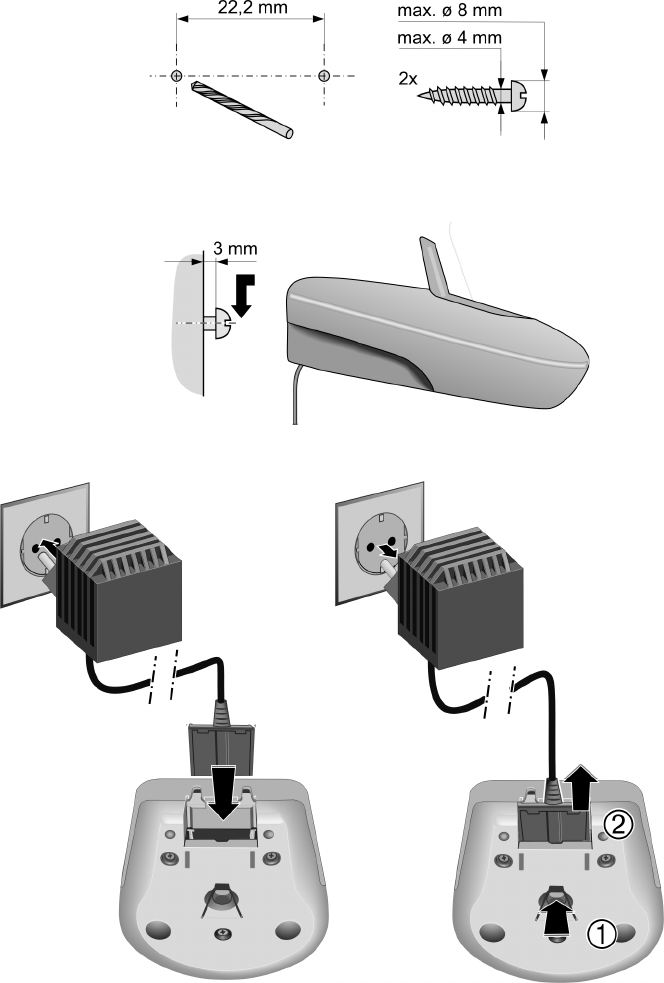
46
Gigaset S450 IP / EN-Master / A31008-M1713-B121-1-43 / montage_charger_base.fm / 7.9.06
Version 4, 16.09.2005